July 20, 2015
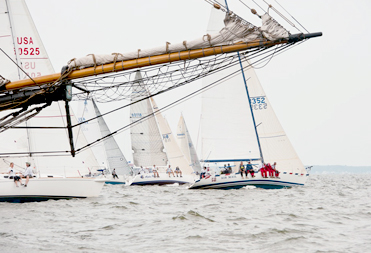
Governor's Cup Grows
This year's 42nd running of the Governor's Cup-the popular overnight race from Annapolis to St. Mary's City-will now include a leg from Mobjack Bay in Virginia. This is the second time the cup has grown to include racers from points south. The first was the addition of the Potomac leg several years ago. For the 2015 race, those who start in Annapolis leg will be met by the
Pride of Baltimore II, which will serve as the committee boat. To those starting on the southern legs, don't dismay, racers and their fans on shore can use a live GPS tracking to follow the race on the race's website and the RaceQs mobile app. And as always, the infamous party after the Saturday morning finish will last throughout the day.
To register for the 2015 Governor's Cup, or for more details, visit
www.smcm.edu/events/govcup or email
[email protected].
July 20, 2015
Look Out Google Maps . . .
If you've ever planned a cruise and wondered when on earth Google maps will send out a boat to map a "street view" of your local waterways, your preview is here. . . . And Google got beat to the punch. Ryan Abrahamsen and Andy Thompson, a pair of hiking and kayaking enthusiasts from the Richmond area, have started a website called Terrain360.com, which provides 360-degree panoramic tours of dozens of hiking, biking and waterway trails in Virginia. Right now, the Bay portion of the project is limited to the James River, though it covers a startling amount of the 350-mile watershed. To get the some 60,000 images, Abrahamsen and Thompson spent several months in 2014 aboard Pocahontas, an aluminum raft with two inflatable pontoons, a couple of comfy seats and a stainless steel telescoping "mast" that carries a six-camera rig that produced 360-degree views. Check it out at
www.terrain360.com.
July 20, 2015
Smith Island Gets New Marsh Land
The U.S. Fish and Wildlife Service has started a massive construction project including more than 20,000 feet of living shoreline near Glenn Martin National Wildlife Refuge's Fog Point. The marshes there will benefit from protective sand and rock structures, which will reduce shoreline erosion, provide habitat for aquatic species, and protect higher marsh grounds from the effects of future storms. The project is funded from a portion of a $102 million allocated to the Fish and Wildlife Service following Hurricane Sandy. To read more on the project and keep abreast of its progress, visit
www.fws.gov/hurricane/sandy/projects/FogPoint.html.
July 20, 2015
Thomas Point Light Going Silent
If you so happen to be out in a fog near Thomas Point Light after about July 20, keep a keen eye out for the beacon of red and white light shining through the haze, as after that date, the iconic light will no longer be sending out a sound signal after the Coast Guard "discontinues" using it.
July 10, 2015
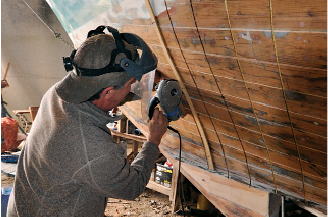 Photo by Fred Stocker
Photo by Fred Stocker
Building a Better Wooden Boat
Since the advent of production fiberglass boats in the 1950s, the idea of owning or building a wooden boat has generally seemed sort of . . . well . . . crazy. At least most folks feel that way. Many would argue that if a maintenance nightmare ever existed, it's a wooden boat. But a well-known boatyard on Maryland's Eastern Shore recently showed me that it doesn't have to be that way. In fact, the 50-year-old yard has a boatbuilding technique that's so clever it was awarded a patent back in 1983. It's called the "Cutts Method," and I paid a visit to the Cutts & Case Shipyard in Oxford, Md., for a closer look.
"The Method," as it is less formally known, is a process for building-or rebuilding-wooden boats using epoxy, wood planks and Kevlar cord. It not only eliminates the use of metal fasteners, which are the demise of many wooden watercraft, but it also creates a hull that is significantly lighter than traditionally built wooden craft. Cutts & Case Shipyard co-founder, Edmund A. Cutts Sr., developed the process.
Cutts Sr. started fiddling with epoxies and modern composite materials while working for Grumman Aircraft in the 1950s at its "Skunk Works" shop. It's a place where lots of components for the U.S. Space Program were born. By the time the '60s rolled around, Cutts Sr. was toying around with epoxy and lengths of stainless steel wire rope embedded in wood planking to enhance the strength of decks on wooden boats. When Kevlar became more widely available in the '70s, Cutts Sr. saw the stronger-than-steel material as a perfect ingredient for his boatbuilding process.
Ronnie Cutts, one of Cutts Sr.'s two sons who now run the Cutts & Case Shipyard, explained the magic to me. He said the idea behind the process is to use two layers of wood planking with perpendicular channels of embedded Kevlar sandwiched in between. That creates a stiff, lightweight hull form without the use of metal fasteners. The process can be used to build a new boat over a framework of temporary support frames (a "jig") or over a boat's existing frames and/or planking, as long as the hull is in good enough condition.
There are a couple of different ways builders can use the Cutts Method, but here's a quick-and-dirty version of how it's generally done: First a layer of wood planking is laid down or a boat's existing planking is freshened up and repaired where necessary. Next, perpendicular grooves are cut into this first layer of planking to accept lengths of Kevlar cord, which is then set into epoxy. A final course of planking is laid down over the previous Kevlar-stiffened layer, using temporary screws to hold the planks down until the epoxy has cured. Then the screws are removed and the screw holes filled.
A final epoxy barrier coat seals the wood planking, virtually eliminating rot. The Kevlar grid is where the magic is, however. That Kevlar cord prevents the planks from moving, either horizontally or vertically. This means the planks can't twist, bend or migrate from where they're fixed.
Ronnie Cutts is currently utilizing the Cutts Method to restore a 33-foot sailboat he saved from sinking into the mud and ice in Baltimore nearly 30 years ago. Country Girl was built at the Oxford yard by yacht designer and builder Ralph Wiley well before Cutts & Case opened up shop there. That's a story in itself.
Stay tuned.
July 10, 2015
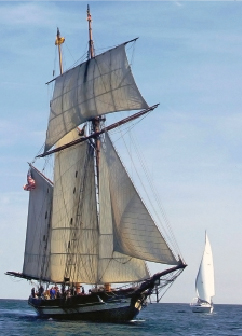 Photo by Jack Chang
Photo by Jack Chang
Pride Sails from Home
She's more used to cleaving waves on her way across oceans under a spectacular array of sail, but the famous topsail schooner
Pride of Baltimore II has been operating out of her home port of Baltimore this summer, offering a rare opportunity for Bay Country residents to have a close encounter with this 109-foot beauty. If your pockets are feeling deep, you might even secure her for a private charter.
Dubbed "Baltimore: Home Port of the Brave," the
Pride of Baltimore II's 2015 sailing season will find her docked at Baltimore's Inner Harbor, where she will be open for deck tours and a limited number of day sail opportunities between Wednesday and Sunday each week through October. Folks will have the opportunity to step aboard and experience the
Pride of Baltimore II through interpretative tours, and interested comers can have a shot at serving as overnight guest crewmembers for a limited number of slots. For more information on the
Pride II's summer schedule, visit
pride2.org.
July 10, 2015
Photo by Gary Reich
The Seeds of Summer
The Rappahannock River Oyster Company (RRO) rears as many as 10 million seed oysters each year to feed its growing oyster farming operations on Locklies Creek a few miles from the mouth of the Rappahannock. Itching to see it firsthand, I set off into the pale dawn light one morning to find out more.
RRO was founded by cousins Ryan and Travis Croxton in 2001 when their family's approximately 200 acres of oyster leases-some dating back as far as 1899-were about to expire. They re-upped the leases, and in 2002 they harvested their first crop-a meager 3,000 oysters. Today, the operation sells anywhere between six and eight million of the briny bivalves each year, shipping them to local eateries as well as fine restaurants like Michelin-starred chef Eric Ripert's Le Bernardin in New York City and Tom Collichio's award-winning Craft restaurants. Revered for their sweet, buttery taste and deep, cupped shape, RRO oysters are favorites at the raw bars far and wide.
The seeds of RRO's success-those 10 million seed oysters I mentioned earlier-come from a nearby hatchery on Gwynn's Island, where every spring, adult oysters are placed in water and warmed up to summertime temperatures (between 76 and 86 degrees Fahrenheit) to induce male and female oysters to release sperm and eggs into the water. In the wild the resulting larvae would naturally drift down on the "parent" bed of oyster shells where it begins to form its own shell. In hatcheries, the larvae are offered microscopic bits of ground oyster shell to stick to instead. This ensures each oyster "spat" develops individually on its own personal piece of microculture instead of bunking up.
Sometime in May, those seed oysters-about one millimeter in diameter and resembling a grain of sand-are placed inside a shoreside apparatus called a stationary upweller. The upweller pulls water from Locklies Creek, drenching the baby oysters in a nutrient-loaded bath. This 24/7 breakfast buffet allows the seed oysters to grow quickly. Eventually they are placed in floating upwellers situated off RRO's docks. Here the tiny oysters continue to feed and are further sifted and sorted until they are about the size of a quarter. Finally they are placed in mesh bags set inside cages that are suspended just off the river bottom where they feed and grow with abandon before the long, cold winter sets in. About 18 months later, those seeds of summer are ready for the raw bar.
Farmed oysters are available even in the dog days of August. That's because they are triploids-they don't spawn (it's all in the chromosomes), thus remaining fat and flavorful all year-round. The saying about eating oysters in months with "Rs" in them is a throwback to pre-refrigeration days when cooler weather made it safer to harvest and ship them. Modern refrigeration means farmed oysters can be harvested and shipped to market safely all summer long. Enjoy.
July 10, 2015
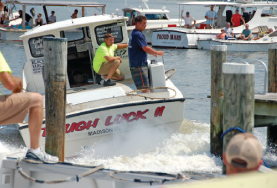 Courtesy of CBMM
Courtesy of CBMM
Watermen-Style Fun
Hooo-weee! Hot steamed crabs, cold brews, a docking contest, live music,
and Deadliest Catch. celebrities? Sounds like the perfect ingredients for the sixth annual Waterman's Appreciation Day at the Chesapeake Bay Maritime Museum in St. Michaels, Md.
There's nothing better than a good old-fashioned, smoke-belching, transmission-grinding docking contest, and the spectacle is one of the primary draws of the event. Workboats will vie for bragging rights by approaching, turning and docking their boats stern-in, and lassoing a set of prescribed pilings in the shortest amount of time. It's an amazing spectacle.
The festival's other big draw is an all-you-can-eat mess of locally caught crustaceans for a reasonable additional price. (Last year's price for all-you-can-eat crabs was $25 and the organizers are shooting for the same prices this year.) Oh, and speaking of crabs-albeit of a different sort-
Deadliest Catch stars will be onsite during the day's festivities. If you've got some wee-ones to tote along, get them involved in some of the kids' activities, which include anchor-tossing and rowing contests, as well as line baiting and other demonstrations.
The event kicks off at 10 a.m. on Sunday, August 9, and runs until 5 p.m. For more information, visit
cbmm.org.
July 10, 2015
Clean Water Gets a Helping Hand
It's hard to imagine the days when boatowners were permitted to simply pump the contents of their marine heads directly overboard into the Chesapeake Bay. Hey, don't worry; we won't paint you a picture. Luckily that practice ended back in 1976 with the passage of the Clean Water Act, which generally requires boats to contain waste in a holding tank and have it pumped out ashore for treatment.
Today that pumping out is simply an unpleasant part of boating life. It's made more unpleasant because finding a pump-out station to deal with the gnarly contents of your holding tank can sometimes be a challenge. Bay-wide there don't seem to be enough pump-out stations in the right places, and if you do find one, more than a few don't work properly. It's a point of frustration for those who try to do the right thing in complying with the law.
A nearly $1 million grant from the U.S. Fish and Wildlife Service aims to take a stab at fixing that problem, at least in Maryland's portion of the Bay. The $900,400 grant, awarded in May to the Maryland Department of Natural Resources (DNR) and announced by U.S. senators Ben Cardin and Barbara Mikulski, will fund DNR's plans to install 10 new pump-out stations, replace or upgrade 30 more, and purchase one new pump-out vessel.
Maryland law requires marinas with 50 or more slips to have an operational pump-out station. Additionally, new or expanding marinas must fit their facilities with a pump-out station. If you do come across a chronically broken pump-out station, DNR encourages boaters to report it by calling 410-260-8772 or emailing
[email protected].
July 10, 2015
The Bourbon-Powered Outboard
You can drown it, torture it and run it on the most out-of-the-ordinary substances, including bourbon. Evinrude's MFE outboards were designed with U.S. military special forces in mind. Heck, they're the only folks who can even buy these extraordinary outboards that will run on Jack Daniels and lie for a week underwater and then start, without tools, within a few minutes of being lifted from the water.
Evinrude has been manufacturing its 55 MFE and 30 MFE engines for the U.S. military since 2009, but it's been only in the last two or so years that I've seen them on display at boat shows. The outside of the outboards features a durable wraparound handle that's used not just for lifting, but also as a handhold for soldiers before they're dropped off at a secret location. Both models look as if they mean business. Evinrude even claims that the stealthy matte-black coating on the outside helps to evade radar. There's a jet version available, too. Well, to the military, I mean.
Aside from being able to start after it's been submerged (special forces teams often sink their inflatable boats offshore then re-inflate them when the job's done), it miraculously runs on a multitude of fuels: jet fuel, kerosene, gasoline, bourbon and yes, even diesel (for short periods). It's all based on Evinrude's two-stroke, two-cylinder E-TEC block, but incorporates some unique engineering to allow it to run on, well, just about anything combustible. The engine's fuel versatility is part of a larger effort by the U.S. military to remove gasoline-fueled equipment from its inventory and pare down to a single universal fuel. I'll drink to that! As for "sucking the monkey," look it up if you aren't aware of that time-honored tradition.
July 10, 2015
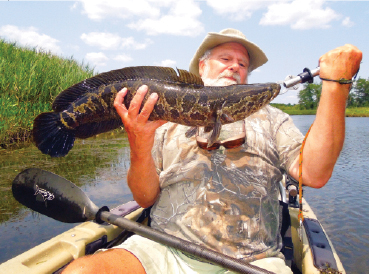 Photo by Joe Bruce
Photo by Joe Bruce
If You Can't Beat 'Em, Eat 'Em
When news of anglers fishing out northern snakeheads from local ponds in Wicomico and Queen Anne's counties came out in late May, we posted a blurb about the discovery on the
Chesapeake Bay Magazine Facebook page. (You know about our Facebook page, right?) We were astounded by the interest our followers showed in this so-called demon fish, the first of which was discovered in a Crofton, Md. pond in 2002.
The toothy northern snakehead fish is an import from Asia that breeds often, grows quickly, and is said to squeeze out local aquatic species from the waters it inhabits by eating everything in sight-turtles, largemouth bass, frogs, even baby ducklings. The crafty critters, which can travel short distances over land, have expanded their range greatly since that first discovery in the Maryland 'burbs. They now widely inhabit the tidal Potomac River, and, more recently, the Patuxent, Nanticoke, Wicomico and Blackwater rivers.
That worries fisheries folks at Maryland's DNR, who are concerned that the species will soon spread to the Choptank River and the Susquehanna Flats. Other people, such as anglers who target the fish for sport, say they haven't noticed the species negatively affecting the area's largemouth bass populations, and that we shouldn't demonize the fish because, well, they're here to stay. But many agree that the best thing you can do if you catch a snakehead is kill it. In fact, it is illegal to possess a live one in Maryland. So, how exactly do we curb this fish's appetite for destruction? Develop an appetite of our own! It turns out that restaurants have taken to serving Northern snakehead and with great success.
One such is the Alewife in Baltimore, which has been featuring snakehead on its menus. The idea is to get people familiar with the fish and then get them asking for it. Creating a commercial market hopefully means watermen will begin harvesting them, curtailing their numbers.
So what the heck does this "Frankenfish" actually taste like? To find out, I attended the 2015 Potomac Snakehead Tournament at Smallwood Park on Mattawoman Creek in Marbury, Md.-a stronghold for these fish. The tournament not only seeks to remove as many of the fish from the ecosystem as possible (the angler who brings in the most pounds of snakehead wins), it also seeks to introduce the fish as a great dining choice. On-site was chef Chad Wells, of the aforementioned Alewife, plus a group of folks having a snakehead fish fry.
Wells was busy grilling snakehead bathed in a tasty sort of teriyaki glaze. I stole a piece off the grill and slapped it on a paper plate. Next door, folks were making "snakebites," little chunks of snakehead battered and deep-fried to perfection. I tried both and have to say it's a good-tasting fish that's mild and has a firm texture. In fact, every person I asked who was trying the fish liked it. More than 200 pounds of the fish were fried, grilled and eaten that day.
And the snakehead tournament? Anglers who participated removed a collective 1,800 pounds of the toothy, slimy creatures from local waters. It's a start.
July 10, 2015
Virginia Doubles Down
Virginia lawmakers took a stronger stand against poaching last spring, approving legislation that nearly triples the time that commercial fishing licenses can be suspended, and giving the Virginia Marine Resources Commission (VMRC) the authority to levy a civil penalty of up to $10,000 against those who fish commercially while their licenses are revoked. "We've seen an uptick over the past year in the most serious oyster violations," says Marine Police Chief Rick Lauderman. "The vast majority of commercial watermen are honest and law-abiding, but a relatively small number of thieves continue to cause a serious problem."
Commercial watermen who ignore VMRC-ordered license revocations and continue to fish, crab and oyster anyway not only face stiffer civil penalties, they may also wind up with a lien on their home or boat. "Governor McAuliffe and the Virginia General Assembly have spoken in a united voice: Oyster thievery must stop,'' says VMRC Commissioner John M.R. Bull. "This new law escalates the potential punishments for egregious violations of our tidal natural resources."
The law went into effect July 1.
July 10, 2015
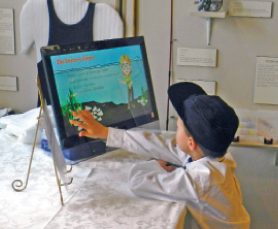 Courtesy of Havre de Grace Maritime Museum
Courtesy of Havre de Grace Maritime Museum
The Community Connection
Our progress along the Havre De Grace promenade abruptly halts. I look up to see my guide standing in front of a tangled mass of foliage that climbs from the ground to the tree branches above us. "This is an example of the invasive species that had been clogging up the marsh here," he says, "but volunteers have helped us remove most of it." To the right of us is cleared wetland that edges into the mouth of the Susquehanna River. The difference is significant. The cleared area is covered only with leaves. "The ultimate goal," he explains, "is to return the marsh to its natural state. Once enough debris has been cleaned up, water will flow in and out of here with the tide."
I've walked this section of the promenade many times, but today I'm with Dr. John Leader, the director of the Havre de Grace Maritime Museum's new Environmental Center. The wetland that surrounds the boardwalk is vital to the health of the river's ecosystem, and yet it can be easy for sightseers to look past it toward the expansive vistas of the Chesapeake Bay. Leader wants to ensure that the marsh gets the attention it deserves, so he plans to post signs along the promenade to provide fun yet informative facts about the ecology of the area. He also hopes that the work done on this section of wetland will soon extend to the rest of Havre De Grace's waterfront. "We want to restore a healthy shoreline for the entire town," he tells me. Doing so will aid in flood control, improve water quality, and bring back native flora and fauna.
An expert in wetland biogeochemistry, Leader grew up in nearby Cecil County and knows the community well. It is his personal mission to inspire others to develop a closer relationship with the Chesapeake Bay so that they can understand the aesthetic and scientific value of preserving it.
The new Environmental Center is located on the ground floor of the museum, and is close to the Bay in every sense, as is demonstrated by electrical sockets that are eight feet high on the walls. "We're in a flood zone here," Leader explains when he notices my puzzled expression. He ushers me into a room that is going to be the new laboratory. "Researchers and graduate students working on the Upper Chesapeake can take advantage of our location and analyze their data here," he tells me.
In an adjacent room sits an empty aquarium tank marking what will become an interactive hands-on exhibit gallery. And then there is the lecture room where, he says, "scientists and speakers will be able to share their research and tell their stories." Meanwhile, students can learn about sustainable practices or how to take and test water samples.
Finally Leader beckons me into his office and pulls something out of a drawer. "I just found this recently with my son as we were exploring Perch Creek." I squint down at the small white object and realize that it's an arrowhead, a reminder that there are still discoveries to make and wild places to encounter on the Chesapeake Bay. Dr. Leader and the staff at the Environmental Center invite you to visit the museum and experience the revitalized wetland before embarking on your own adventures.
For more information about the new Environmental Center visit the museum's website at
www.hdgmaritimemuseum.org.
-
Kevin Chalk
July 10, 2015
Courtesy of Hooper Island Oyster Aquaculture Company
Oyster Wars Redux
When the Maryland Watermen's Association backed a bill that would potentially limit the availability of oyster leases for aquaculture, Maryland oyster growers fought back by forming the Maryland Shellfish Growers Association to lobby on their behalf.
House Bill 419, introduced by Rock Hall Delegate Jay Jacobs at the urging of local watermen and landowners, would have required the Maryland Department of Natural Resources to consider a variety of concerns regarding the location of new oyster leases, including objections from surrounding landowners and commercial watermen who consider open water free territory. While the DNR currently takes such concerns into consideration, leases are issued based on a different set of criteria. They cannot block access to a private dock, for example, and they must stay clear of channels and most navigable water.
Bill 419 did not pass this year, but Johnny Shockley, president of the new growers association wants to make sure that aquaculture proponents have a stronger voice in future debates. With ten or so founding members, the MSGA plans to hold industry meetings in August and begin accepting additional members. To contact the MSGA for more information (or to join) call or e-mail Johnny Shockley: 410-397-3664;
[email protected].
July 10, 2015
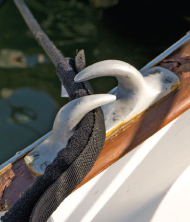 Photo by Gretchen Hannsz Witzgall
Photo by Gretchen Hannsz Witzgall
Chafe-Pro packs a wallop! says veteran cruiser Gretchen Hannsz Witzgall.
The wind was blowing 40 knots, whipping the waves to a frenzy and making our rigging shiver. This was during our six-month cruise from the Bay to the Bahamas back in 2012. We had chafe gear on our snubber, and the boat's motion was giving it a run for the money. We rode out plenty of storms on that trip, and it seemed like our chafe gear wore through quickly.
We learned the hard way that not all chafe gear is created equal. When we spotted the Chafe-Pro booth at one of the Annapolis boat shows, we grabbed it. Just by looking at it we could tell that it was more substantial than the brands we had used in the past. Basically it consists of a thick skin of nylon webbing that wraps around a dock line and stays put with heavy-duty Velcro.
Since we were getting ready to set off on another long haul (to Maine and back), we ponied up for Yacht Series 06-98Y-16 (for our 3/8-inch dock lines) and 05-98Y-14 for our snubber. It was pricier than what we had used before, but we thought it well worth the outlay. We figured it was cheaper than buying new dock lines every time we came back from a trip.
Experiencing storms at anchor, we know the importance of having a good snubber system (to absorb the shock of our anchor chain) and good chafe gear to protect the snubber. Our new Chafe-Pro gear protected our snubber line at anchor and while using mooring balls on our Maine cruise. We noted that it was wearing much more slowly than our previous gear, and while a bit stiffer, it was still easy to use and lead through our bow chocks.
We are back in Annapolis now, still living aboard but on a considerably larger and heavier boat. We've continued to use Chafe-Pro, and even after being docked against a sea wall for six months, our Chafe-Pro guards look practically like new despite their faded labels.
Chafe-Pro gives us peace of mind that our lines won't chafe and leave our boat vulnerable. Not having to replace our dock lines translates into less general expense-not to mention the fact that the longevity of the chafing gear itself has felt like money in our pocket. We recommend that you check the Chafe-Pro systems out at
www.chafepro.com.
Thanks to Gretchen and Chris Witzgall, aboard Gossamer in Annapolis. (Gretchen just happens to be CBM's circulation manager, and the only way we could get any peace and quiet in the office was to let her rave about her chafing gear.)
We're happy to tell our readers about tried-and-true products you've encountered along the waterfront. Send your boatkeeping tip long or short (photos are welcome) to [email protected]. If we print it, we'll send you a hat.
July 10, 2015
Photo by Craig Williams
The Stars of August
During the second week of August (the nights of the 11th through the 13th to be exact) Earth plows through a cosmic stream of comet dust, giving us one of the most spectacular (and reliable) meteor showers of the year.
The so-called Perseid shower seems to fly out of a constellation named for the Greek hero, Perseus. (He's the guy who slew Medusa and saved Cassiopeia from a deadly sea serpent.) Perseus rises off the northeast horizon at around midnight. By 1:30 in the morning, it is fairly high in the sky and easy to spot (see graphic). The higher it gets, the more meteors you'll see. Stargazers in dark areas could count as many as 100 meteors per hour at peak.
Most of these comet bits are tiny-smaller than a grain of sand. But when they hit the Earth's atmosphere at 100,000 miles per hour they burn so brightly you can see the glow 40 to 60 miles above your head.
The shooting stars leave trails that typically fade from sight within a few moments (have your wishes ready), but with binoculars you could see the trails twisting in upper atmosphere winds for as long as a minute.
You may also be able to see our nearest galactic neighbor, the Andromeda Galaxy. It's a nice ghostly target for binoculars, stretching about twice the width of the full moon. Look for it near the square of stars representing the constellation we call Pegasus.
This year the moon is going to set well before the meteors start, so you have an excellent chance of seeing a good show. Remote coves on the southeast of the Bay will give the darkest skies and the best viewing.
-
Craig Williams
July 10, 2015
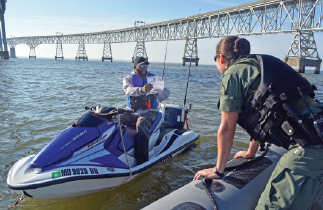 Courtesy of Maryland NRP
Courtesy of Maryland NRP
365 Days of Fishing in Maryland
If you've ever done any recreational fishing in Maryland, you know that the state hasn't always been what you'd call ahead of the curve when it comes to licensing. Not only did it take what seemed like forever for the Maryland Department of Natural Resources (DNR) to implement foolproof online licensing, but the licenses you got were good only for a calendar year. That meant if you purchased an annual recreational fishing license in June, it expired on December 31, no matter what. Not such a great value. Well, thanks to a push from the leadership team at Coastal Conservation Association Maryland, that's about to change.
Maryland Governor Larry Hogan signed legislation that changes Maryland's current calendar-year fishing scheme to a 365-day model, just like Virginia's. Starting October 1, all recreational fishing licenses issued in Maryland will be valid 365 days from the date of purchase. The new law covers recreational tidal and non-tidal fishing licenses, including the popular Chesapeake Bay and Coastal Sport Boat License.
For more information, visit Maryland's online licensing portal at
compass.dnr.maryland.gov/dnrcompassportal.
June 15, 2015
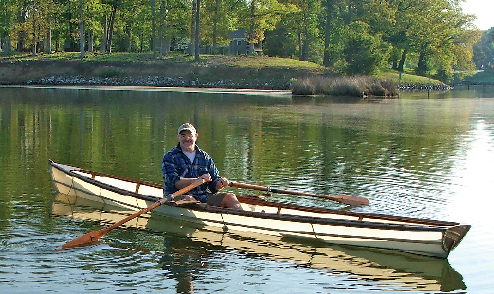 Photo by Zora Aiken
Photo by Zora Aiken
Floating Pretty
Everything old is new again-especially under the capable hands of someone like Dave Gentry, whose hand-built "skinboats" reflect an old tradition with a high-tech twist. Imagine a prehistoric Arctic sea kayak crafted by fastening a seal skin over a framework of wood. Or a wicker-and-cowhide vessel. Nowadays, countless generations later, modern boatbuilders still produce "skin-on-frame" (SOF) boats or "skinboats," but their construction methods have changed. Instead of traditional ribs, Gentry fashions his frames from marine-grade plywood and uses industrial-grade polyester and nylon fabrics as the "skin."
Gentry opened his first shop in 2006 in the state of Washington, where he turned out standard wooden kayaks for a cadre of local buyers. Until, that is, he saw a friend's skinboat and decided to build one for himself. It took him a matter of weeks, rather than months, and the end result was a boat that was half the weight of a similar design made of wood, fiberglass or composite.
"That fit perfectly with my belief that the easier it is to use a boat, the more use it will get," he says. "If a person can lift and move a boat without help, it can be car-topped and launched easily anywhere there is shore access-no crew needed, no launch ramp required."
It was a short step from building individual skinboats for clients to selling skinboat plans-and ultimately skinboat kits-to do-it-yourselfers. SOFs are surprisingly easy to build, even if a person has no boatbuilding experience or special carpentry skills. Only a small number of common tools are necessary for the job.
Gentry has developed a remarkable collection of designs for the wannabe builder. Many are nontraditional skin-on-frame versions of boats found in museums, perhaps a nod to the builder's graduate degree in history. Gentry's boats are also connected by their style, a definite nod to the artist's eye.
His designs include kayaks, canoes, sailboats, rowing boats and a paddleboard. Recently out of his backyard workshop and dock in Weems, Va., is the 10-foot-6-inch Wee Lassie, designed in the late 1800s by J. H. Rushton. Gentry's version sports a clear vinyl skin to give an elegant look to the little go-anywhere canoe. Still in the shop is a unique 17-foot canoe inspired by a dual-outrigger sailing canoe from Java.
When he opened his boatbuilding shop, it was with mixed feelings about making a career out of what had been recreation. In college, he coached the sailing team and got involved with class racing. He traveled the country for a time, filling his calendar with Laser and 470 regattas. Then came surfing, whitewater kayaking, rowing, even a time of cruising on a sailboat.
Settling down in the Chesapeake has not stopped all his travels; He still teaches and conducts boatbuilding projects for clubs, schools and corporations around the country, from the WoodenBoat School in Maine to the Family Boatbuilding weekend in Mystic Seaport. He recently conducted a four-day workshop for a group of wounded warriors through the organization Heroes on the Water.
"I'm lucky," he says, "that boatbuilding has presented so many different opportunities for me: design, building, restoring and teaching. Because of the variety, I enjoy them all."
Soon, perhaps, he may add a new design to his mini-fleet, something just about the right size for a toddler, as he and his wife Anna introduce their daughter to the joy of small boats.
To learn more about Dave Gentry's boats, visit
www.gentrycustomboats.com. -Zora Aiken
June 15, 2015
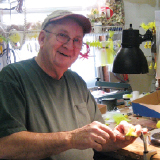 Captain George W. Bentz
Captain George W. Bentz
In Memoriam:
GEORGE BENTZ
Fisherman Extraordinaire
The Chesapeake's recreational fishing community lost one of its patriarchs when George Bentz, 78, died in April after a long illness. As founder (with his wife Ellie) of the "No dues, no politics, just fish talk" Pasadena Sportfishing Group (PSG;
www.pasadenasportfishing.com), George helped fishermen gather together, swap information, and introduce young people to the sport. PSG still draws a hundred attendees of all ages on the first Monday of each month to eat supper, listen to a speaker, hand out door and raffle prizes and talk fishing. The group participated actively in developing public fishing access at Downs Memorial Park and a much-needed boat ramp at Fort Smallwood Park.
Bentz grew up in Baltimore, but from age four on, he spent as much time as he could with an uncle who had a cottage "in the country," which in the 1940s characterized Bodkin Creek, at the mouth of the Patapsco River. There he learned to row a skiff, catch crabs, gather grass shrimp for bait and fish for then-abundant yellow perch with a cane pole, a two-hook "spreader rig" and a brightly painted cork bobber. His uncle always warned him not to go out at night, though, because the yellow-bellied-sapsuckers and drizzle bars would get him.
After they married, George and Ellie bought that cottage and raised a family. He worked at the former Westinghouse Corporation installation (now Northrup Grumman) near BWI Airport. The cottage became a house, and the dock grew to accommodate larger boats so George could fish the Chesapeake Bay Bridge for rockfish. He built most of the lures he used.
"Dad knew he had been privileged to grow up with the riches of the Chesapeake, and he wanted to share what he had learned with friends and succeeding generations," said his son, Captain George W. Bentz, who today runs his charterboat from that dock "in the country." She's a handsome 46-foot Markley named (did you guess it?) Drizzle Bar, and until a couple of years ago, his mate was, yes, his father. Fair winds and pretty rockfish to you both, George and Ellie. Thanks for all you contributed to the Chesapeake's angling community.
-John Page Williams
June 15, 2015
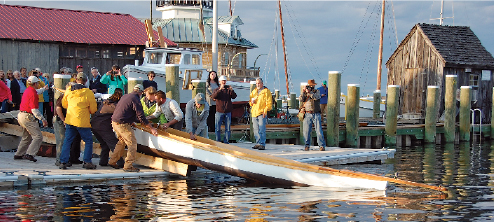 Photo by Michael C. Wootton
Photo by Michael C. Wootton
Can You Canoe?
Hear the word "canoe" here in Bay Country, and chances are someone is referring to an over-canvassed wooden sailing craft that glides gracefully across the water with crew members scrambling out on wooden planks to keep it from heeling over too much and capsizing. The sight is about as Chesapeake as Chesapeake gets-even if there are only a handful of the boats left.
Thanks to folks at the Chesapeake Bay Maritime Museum (CBMM) in St. Michaels, Md., the Chesapeake log canoe fleet recently grew by one. Shipwrights, apprentices and volunteers toiled in the museum's boatshop this past winter to craft Bufflehead, the first two-masted log hull sailing canoe to be built on the Bay since 1979. She slid quietly into the harbor at St. Michaels in late April.
Log canoes, and the methods by which they are built, are indigenous to the Chesapeake Bay. While more "modern" designs date back to the 1800s, log canoe DNA can be traced back to the dugout canoes created by the Powhatan Indians. Watermen added sails to help speed them to and from fertile oyster grounds. Nowadays the fleet is used almost exclusively for racing. Spectators can watch them sparring during weekend regattas, primarily in the Miles, Choptank, Tred Avon and Chester rivers.
Yes, log canoes are built from logs. The process starts by binding three to five loblolly pine logs together, and then hacking away at them with axes and adzes until a hull shape emerges. One or two additional planks form the hull up to the deck. Bufflehead's lines came from an 1893 Robert D. Lambdin log canoe in the museum's collection.
So what does the museum plan to do with Bufflehead now that's she finished? "Race as many races as possible," says CBMM Boatyard Manager Michael Gorman, adding, "We may not have a full rig and new sails until the middle of the race season this year, but we will fully participate next year, for sure."
For the log canoe race schedule, visit
www.ChesapeakeBoating.net.
June 15, 2015
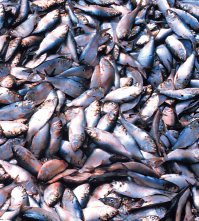
Little Fish, Bigger Bag
In May, the Atlantic States Marine Fisheries Commission (
www.asmfc.org) voted to increase the coast-wide catch of Atlantic menhaden (Brevoortia tyrannus) by 10 percent for the 2015 and 2016 fishing seasons. This action is a partial relaxation of the 20 percent catch reduction the Commission had enacted in December 2012; it was based on a new stock assessment that found more large, older fish in New England waters in the summertime, raising the overall estimate of menhaden biomass. Menhaden play a critical role in the food webs of Atlantic coastal waters.
Omega Protein, the Reedville, Va., company that harvests the small, silvery fish for animal feeds and human diet supplements celebrated along with the watermen who harvest the fish for bait. Conservationists, however, noted that in spite of the higher biomass, menhaden numbers remain extremely low overall, causing a shortage of the nutritious, oil-rich fish for their natural predators, including rockfish, bluefish, ospreys, gannets, loons and even whales.
To address those concerns, ASMFC's Menhaden Board directed its Technical Committee of fishery scientists to begin a formal process to evaluate the ecological roles of menhaden in the Chesapeake (which serves as a major nursery for the fish) and along the Atlantic coast. That committee's findings will be incorporated into quantitative "reference points" that will be used to determine catch limits in the future. Though less obvious than the increased catch limit, this action will have much greater implications for future management of this species, which has been called "the most important fish in the sea."
-John Page Williams
June 15, 2015
 Photo by Chelle Fulk
Photo by Chelle Fulk
Driftwood Menagerie
For Chesapeake Beach artist Larry Ringgold, a typical shoreline stroll can unveil the foundation of several creative ventures: the beak of an eagle; the legs of a stallion; the mane of a lion. He spends hours mining beaches for inspiration squeezed, of all places, through the porous, salty membranes of sea-soaked driftwood.
Ringgold, a retired carpentry teacher, crafts elaborate figures (nearly life-size) using pieces of driftwood he's collected from local Chesapeake Bay and Potomac River shorelines. Possessing an inherent talent for discovering profound character where one would expect little to exist, Ringgold initially explored the untapped personality of driftwood when he found several thousand pieces of it beached by recent hurricanes. The wood had an eerie talent for evoking, say, a bird or a horse, when viewed at a particular angle. "Wood has so much character . . . I'm seeing something there, and I want to develop that," Ringgold says.
Ringgold drew from his carpentry skills to develop a self-styled creative process that demands weeks of rigorous work. He begins by searching isolated beaches for a piece of wood that hints at a particular shape. "The first piece of wood sets the whole movement of the figure. It's the most difficult one to find," Ringgold says.
After collecting more driftwood that complements the original piece, Ringgold begins the process of constructing a full-size figure, first calculating which pieces of wood will naturally fit together to form the anatomy he intends to create. He then fastens the appropriate pieces of the puzzle together using ceramic-coated finishing screws (he locks the smaller pieces together with glue and brads). That done, he trims excess wood from the figure and sands out the rough edges. Using a combination of power washing and bleach, he cleans the figure, removing sand, dirt and algae before applying five or six coats of paraffin-based exterior finish to enhance the wood's natural appearance.
The resulting figure is stunning, to say the least. Ringgold's "Dinnertime" sculpture portrays an eagle swooping to pluck a fish from the sea; the artist's dedication to detail shows in its intricately chiseled wing curvature and determined predatory posture. Another standout, "Sea Lion On the Prowl," replicates a lion in mid-stride. "Willow" depicts a stallion sporting a beautiful midnight coat and a distinctly confident carriage-incredibly life-like at seven feet tall!
Today, Ringgold's driftwood craft is a full-time job, and the multi-layered artistic process demands a seven-day work week (retirement, what?). But his efforts have paid off in spades. Single sculptures now sell for up to several thousand dollars, and each new piece feels more lifelike than the last. "I've come a long way," Ringgold chuckles. "With the first horse I made, I didn't even realize the legs went the other way."
For more information about Ringgold's driftwood sculptures and his upcoming art shows, visit his website at
turtlepointdriftwood.com.
-Kyle Jenkins
June 15, 2015
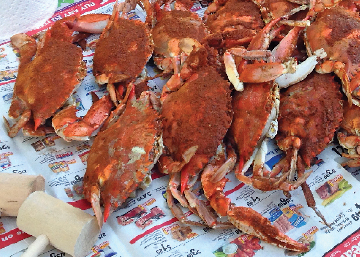
Coming Soon to a Newspaper-Covered Table Near You
The results of the recently released 2015 Blue Crab Winter Dredge Survey will be music to your ears if slurping some suds while picking at a pile of steamy spiced blue crabs on a sultry summer afternoon is what you're all about. (But the music might not be from your all-time favorite group.)
So what the heck is the Blue Crab Winter Dredge Survey? Well, since 1990, the Maryland Department of Natural Resources (DNR) and Virginia Institute of Marine Science (VIMS) have been employing dredges from December through March to obtain crab samples at 1,500 sites throughout the Chesapeake Bay. By sampling during the winter, when blue crabs are usually tucked away under the mud and stationary, scientists can develop estimates of the number of crabs present in the Bay.
This year scientists discovered that while the overall number of crabs in the Bay is estimated to have increased by 38 percent, to 411 million, the population of female crabs still remains low. The abundance of spawning-age females is estimated to be 101 million-a 47 percent increase, but still below the target level of 215 million. Additionally, the 2015 survey shows that the overall population of crabs is 43 million crabs below the 26-year average of 454 million. Remember how difficult this past winter was? The crabs felt it, too, and 19 percent of the population perished, presumably as a result of the record cold.
All that said, there were some bright spots in the survey. The population of juvenile crabs was up 35 percent, to 269 million, and fisheries scientists commented during a media call that many of these fast-growing critters should reach harvestable size toward the middle to latter part of the season (which ends in December). Also, fisheries managers said that the exploitation rate, or removal of crabs from the Bay, is around 17 percent. That's far below the harvest target of 25.5 percent and maximum safe level of 34 percent.
Despite the low numbers of females, which are crucial in maintaining a healthy crab population, the overall positive numbers should be welcome news for both the watermen who harvest blue crabs, and the folks who enjoy catching and eating them . . . or just eating them. You can read the full results of the survey by visiting
dnr2.maryland.gov/fisheries/Pages/blue-crab/dredge.aspx.
June 15, 2015
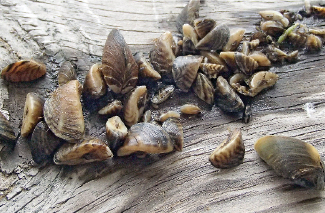
Boaters Asked to Flex Their Muscles Against Zebra Mussels
You may have heard of the zebra mussel, the small mollusk with a nasty habit of clustering up and clogging intake pipes, encrusting underwater gear, and creating general mayhem for industrial equipment beneath the water's surface. Present in the Upper Bay below the Conowingo Dam since 2009, the Maryland Department of Natural Resources (DNR) reports that numbers of the zebra mussel in the Upper Bay are on the rise.
Introduced inadvertently to the Great Lakes in the 1980s, these mollusks get their name from the striated pattern on their shells. Left to their own devices, they grow in vast colonies, expanding in dense packs that not only clog the pipes for municipal water supplies and power plants, but also might carry avian botulism, increasing the likelihood of harmful algal (Microcystin) blooms. Recent Upper Bay surveys and reports from watermen and residents show that zebra mussels are successfully reproducing in and around the Susquehanna Flats. Boaters can help prevent the further spread of the zebra mussel in the Upper Bay by following these simple tips, courtesy of DNR:
• Remove all aquatic plants and mud from boats, motors and trailers, and put the debris in trash containers.
• Drain river water from boat motors, bilges, live wells, bait buckets and coolers before leaving, to prevent these aquatic hitchhikers from riding along.
• Dispose of unused live bait on shore, far from the river or Bay, or in trash containers.
• Rinse boats, motors, trailers, livewells, bait buckets, coolers, and scuba gear with high pressure or hot water between trips to different water bodies. • Dry everything for at least two days-preferably five-between outings.
• Limit boating from place to place-particularly between the Susquehanna and Upper Bay to other water bodies in Maryland-where zebra mussels haven't invaded.
If you live or boat on the Upper Bay, DNR also asks that you report any suspected sightings by e-mailing
[email protected] or calling 410-260-8604. More information is available at
dnr.maryland.gov/invasives/ZebraMussel.asp, where you can find a fact sheet that differentiates zebra mussels from their lookalikes.
June 14, 2015
Don't Forget the Flares
"What's the most common safety violation you see?" I ask Officer Chris Neville, as the three-year Maryland Natural Resources Police veteran points his patrol craft toward the open Bay. "Expired or missing flares is a very common violation . . . and one we write lots of citations and warnings for," Neville says, adding, "Certain vessels are required to have visual distress signals aboard. While most classes of boats can simply carry a day signal, like an orange and black flag, most boaters choose pyrotechnic devices (flares), because they satisfy both day and nighttime signaling requirements."
Safety was the order the day when I accompanied officers Neville, McFarland and Colon on a patrol off Sandy Point State Park for the opening day of the Spring Trophy Rockfish Season in April. "This is the first run of the season, for many folks," says Neville. "We'll find a lot of folks today who spent more time prepping their fishing tackle than checking their safety gear inventory. It's a good opportunity to remind boaters what gear they need aboard, and to make sure they're safe. I can guarantee that we'll find plenty of boats with missing or expired flares, as well as other safety gear," he adds.
While the first three boats we stopped-a small center-console, a kayak and a personal watercraft-were in check, the fourth vessel, a small cuddy cabin, had expired flares aboard, prompting Neville to issue a warning citation. We'd write a few more warnings for expired or missing flares over the course of the patrol, but it was nice to see that all the boats we stopped had the proper number of personal flotation devices aboard, including a throwable Type IV device. "Missing lifejackets are a nonstarter and guarantee a ticket and fine," says NRP Public Information Officer Candy Thomson, who also accompanied us on the patrol.
Neville told me that they typically issue warnings for expired or missing flares during the day, but always write a ticket that carries a fine if they find a boat operating at night without proper signaling devices aboard. If you haven't made a check of your boat's safety gear, now's the time to do it. To get the details on the safety requirements for your boat, including boating safety education requirements, visit
www.dnr.state.md.us/boating/pdfs/recreationvessels.pdf
June 15, 2015
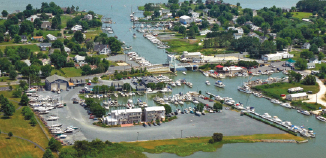 Photo courtesy Knapps Narrows Marina
Photo courtesy Knapps Narrows Marina
Dredge Baby, Dredge
Federal solicitation and public notices posted in late April suggest maintenance dredging for the channel through Knapps Narrows could soon begin. The project aims to deepen the channel that links Eastern Bay and the Choptank River to a depth of nine feet (MLW). Last dredged in 2007, frequent reports from cruising boaters confirm it has silted over in many places. Stay tuned.
June 15, 2015
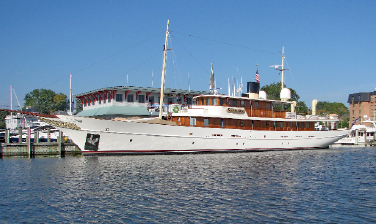 Photo by Karen Ashley
Photo by Karen Ashley
Maryland is for Megayachts
While major ports like Baltimore, Norfolk and Annapolis certainly can't compare to the megayacht metropolis of Fort Lauderdale, a new law signed by Maryland Governor Larry Hogan aims to increase the number of "super-size-me" yachts that make annual pit stops on the Chesapeake Bay.
Thanks to a lobbying effort by the Marine Trades Association of Maryland and Baltimore Marine Centers, a law was signed in April that applies to foreign-flagged yachts, or U.S.-flagged vessels up to 200 feet that engage in foreign trade (think charter boats and small cruise ships). These vessels make up the biggest piece of the U.S. East Coast megayacht pie. Previous rules required vessels 79 feet and over fitting the above descriptions to secure a pilot at the owner's expense before entering the Bay. Besides the hassle factor, the $250-an-hour (or more) trip under the watch of a pilot could definitely eat into the discretionary happy-hour funds, effectively reducing the number of these high-rolling yachts willing to venture up the Bay shedding dollars along the way.
So, what's the big deal for the state of Maryland? Consider that a 199-foot Feadship can hold as much as 36,000 gallons of fuel. Even if that yacht only requires a top-off, 10,000 gallons of diesel fuel could mean a $27,000 to $30,000 tab at the fuel dock, based on current average prices. Then there's dockage, at $5 per foot, per night or more. Factor in the expenditures that passengers and crews make during their visits, and the cash starts to pile up. Not surprisingly, Maryland wants its cut of that cash.
Delaware currently requires all vessels over 100 tons to utilize the services of a pilot to navigate in its waters, while Virginia requires a pilot on any vessel over 300 tons. And what if you're the captain of a 150-footer and you want to hire a pilot? You'll still be able to do that, at your own expense. Not a bad problem to have.
June 14, 2015
Message in a Bottle
The first thing beachcomber Pat Meneely (who happens to be editor Janie Meneely's sister-in-law) did when she found a message in a bottle washed up on Bay Ridge Beach outside Annapolis was to check that no one was in trouble. Then, she got inspired. "Keep your head up . . . Keep Your Heart Full," it read, a few simple words to brighten anyone's day. When she showed it to us, we noted the hashtag #DriftingHope. Turns out the "bottle tosser" is none other than Jeffrey Brant, an aspiring filmmaker from Nashville, Tenn., whose mission is to inspire others "to be better people." Since April, he's put uplifting quotes in bottles and chucked them into waterways from New York to Tennessee. To keep the spirit moving, we've put a new message in the bottle and set it adrift again. If you find it let us know on Twitter @ChesBayMag (and @DriftingHope). Then, pass on the good vibes.
June 15, 2015
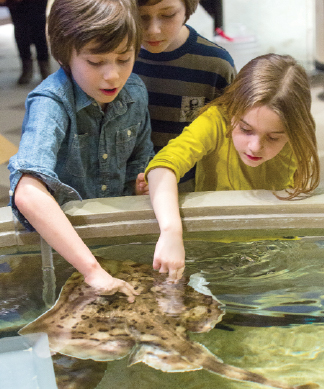
New Exhibit: Please Touch
Its most interactive exhibit yet, the National Aquarium's Living Seashores offers visitors the chance to get their fingers wet while learning about the ever-changing mid-Atlantic shoreline.
It's all about touching things. Two pools (containing 5,331 gallons of seawater, no less) hold up to 150 different animals representing 20 different species of underwater denizens. Crabs, skates, whelks, even moon jellyfish glide through tanks that sit low enough to the ground that little people can reach easily over the edge to stroke a passing stingray (among other sea creatures).
Digital touch-tables and computer touchscreens provide more information about exhibit residents. Look through a set of digital boardwalk-style binoculars to see videos of non-resident animals in their natural habitat.
The aquarium opens at 9 a.m. seven days a week. Admission price is $35 adult; $22 children (group rates apply to groups of 15 or more). For more information go to the museum's website at
www.aqua.org.
June 14, 2015
If at First You Don't Succeed . . .
According to a recent article in the Bay Journal, Chestertown, Md. native Scott Budden was tickled in May 2014 when the Maryland Department of Natural Resources approved his application for an oyster lease north of Ringgold Point on the Chester River. And you'd be tickled, too, if you'd spent three years planning and preparing with as much detail and forethought as Budden did. But others weren't as excited about the prospect of Budden's oyster cages peppering the bottom of the Chester River.
Wayne Wilson, a local waterman, protested the lease within the 30-day comment period following the lease approval, and, before long, Kent County Commissioner Ron Fithian and the Napley Green Gun Club were in the mix, questioning the approval of the aquaculture operation. "I opposed it for one reason-to bring attention," Fithian said to the Bay Journal, adding, "I heard there was some opposition. I forced it to come to a public hearing." The gun club contended that Budden's operation would interfere with its hunting operation.
In a spurt of good news for everyone involved, a compromise was reached in April. It allows Budden to work his original lease while a new lease next to the Eastern Neck National Wildlife Refuge awaits approval. Once the new site is approved, he will move his operation there. He hopes to have his first crop of market-size oysters ready in two years.
Despite the Maryland Department of Natural Resources' opening up vast areas of bottom to aquaculture leases since 2009, the region has a reputation for being a difficult place to start oyster farming. It's so difficult, in some cases, that Senator Barbara Mikulski in May inked her pen and asked the U.S. Army Corps of Engineers to stop "dragging its feet" in issuing leasing permits for oyster farmers.
While plenty of folks seem to agree that oyster farming is an ideal solution to helping the Bay's oyster population recover, others say it clogs up and closes off areas that are also productive grounds for crabbing and clamming.
A recent New York Times article highlighted the opinions of the Maryland Waterman Association's president Robert T. Brown, who says, "You don't put one person out of business to start another [business]. If you put a bunch of cages on the bottom of the water, how are you going to put your trotline down? You can't sift for crabs, you can't clam there, you can't fish there, and you can't even sport fish there. I am worried about all of it."
Since 2010, Maryland has granted more than 300 aquaculture leases, covering approximately 4,000 acres of Bay bottom.
June 14, 2015
Boatkeeping Tip
Every boat inevitably winds up with mold and mildew. Alberg sailor Mike Lehman says Mr. Clean Magic Erasers make short work of cleaning up the mess. They can be used on painted surfaces, wood and fiberglass. "We keep several on our boat at all times," he says, adding that his boat's name is Gilleleje. "It's a small seaside village in Denmark where we had our honeymoon, " he says. "So we have the name Gilleleje with a hailing port of Arnold. My cousin in Denmark has a boat named Arnold with the hailing port of Gilleleje."
Send your boatkeeping tip to
[email protected]. If we print it, we'll send you a Chesapeake Bay Magazine hat.
June 14, 2015
Clam Slam Rolls Into Cape Charles
If you're like us, you're all about a good old-fashioned gear-grinding, transmission-crunching, smoke-belching workboat docking contest, which is reason enough to attend the fifth annual Clam Slam in Cape Charles, Va. But add in Smith Island Skiff races, clam-eating contests, crab-float races, live music and all sorts of other waterfront mischief, and you've got the makings for an incredibly good summer festival.
Celebrating the area's status as one of the top clam-producing regions in the United States, the Clam Slam fun starts Friday, July 31 and runs through Sunday, August 2 on Cape Charles's scenic waterfront. Friday features the clam-eating contest, accompanied by live music and good food, while the fifth annual Clam Slam Khedive Shriner Parade, Smith Island Skiff races and docking contest practice runs happen during the day and into late afternoon Saturday. The aforementioned transmission-crunching, smoke-belching workboat docking contest kicks off Sunday afternoon at 1:05 p.m. Be there, or be square. Visit
capecharlesbythebay.com/event/clam-slam-2 for more information.
June 14, 2015
What's That You Say?
Nautical lingo is an exacting, if exasperating, science.
Words have a perverse way of eeling around us as time passes and they slide into the common vernacular. Yachting terms can be especially slippery. Take the term "saloon."
When you leave the cockpit, step down the companionway, pass through the galley and sit on the comfy cushions around the table, you are properly in the vessel's saloon. Absolutely.
But what is there about your paneled, elegantly appointed cabin that connects it to Duffy's Saloon at the corner of Rye Avenue and Souse Street? It doesn't compute, not even if you sprinkle sawdust, peanut shells and stale beer across the cabin sole.
Most dictionaries define the word in two ways: 1-a public establishment where alcoholic drinks are served; 2-the living spaces of a yacht. The word has an impressive pedigree which Webster's Dictionary explains thusly:
French salon, from Italian salone, augmentative of sala hall, of Germanic origin; akin to Old High German sal hall; akin to Lithuanian sala village. First Known Use: 1728
We are informed that those among us with powerboats prefer the term salon, but this is an affectation. Go to a salon to get your hair marcelled. Captain Nathaniel Herreshoff, conversant with both power and sailboats of modest and mighty proportions used the word saloon. Case closed.
-Jan Adkins
June 15, 2015
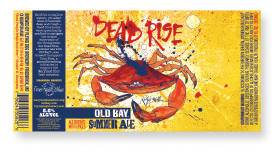
Three Cheers for Beer: Bay Brews Aim To Save Bay, Oysters
It's certainly not news that the country is smack dab in the middle of a craft beer craze at the moment. It's also no secret that Chesapeake Bay boaters, anglers and other Bay lovers enjoy kicking back with a cold one, whether it's while sitting at anchor in a secluded cove; bellied up to a pile of steamed hard crabs; or laid back at a dock bar watching the tide go by.
But what if we told you that your next six-pack could help save the Bay, or fund oyster restoration efforts? Well, thanks to a handful of local breweries and organizations, your next sudsy mugful could do just that. Now, before we get started, we know we don't have to lecture you about the responsibility that comes with enjoying these refreshing beverages while afloat or on land, right? Or did we just do that?
Deadrise Old Bay Summer Ale As the name suggests, this spicy summer seasonal ale is spiked with the Chesapeake's beloved Old Bay Seasoning and brewed by Flying Dog Brewery in Frederick, Md. A portion of the proceeds benefit True Blue, a state program designed to promote the watermen who harvest blue crabs exclusively from Maryland waters and the restaurants that serve them.
flyingdogbrewery.com/beers/dead-rise
Striped Bass Pale Ale Everyone knows cans work better on boats than bottles, so that's the only way this somewhat hoppy pale ale from Devil's Backbone Brewing Company of Lexington, Va., is available. Well, unless you're on land; then you can also enjoy it on tap. The brewery's founder, Steve Crandall, conceived the brew on a fishing trip. A portion of the proceeds from this brew goes to help fund the Chesapeake Bay Foundation's efforts to restore and protect the Bay.
cbf.org/striped-bass-pale-ale
Rosie Parks Oyster Stout Chesapeake Bay oysters are brewed into this thick, chocolate-colored stout, giving it a slightly briny finish. Brewed by the Fordham Brewing Company of Dover, Del., this beer is named after the skipjack Rosie Parks, originally built by Mr. Bronza Parks in 1955 and fully restored to her original condition by the Chesapeake Bay Maritime Museum (CBMM) in 2013. A portion of the proceeds helps fund CBMM's mission to preserve the Bay's cultural history.
Pearl Necklace Oyster Stout The oysters that flavor this dark concoction from Flying Dog Brewing Company come from the Rappahannock River Oyster Company, a sustainable oyster farming operation situated on the Rappahannock River in Tappahannock, Va. Drink this full-flavored stout and help fund the Oyster Recovery Partnership, an organization that coordinates oyster restoration projects all around the Chesapeake Bay.
flyingdogbrewery.com/beers/pearl-necklace
The Bay IPA A relative newcomer on the feel-good brew bandwagon, The Bay IPA is a hoppy India pale ale from Full Tilt Brewing of Baltimore. Introduced in February, this beer has feisty and astringent notes on the back end. Enjoying this beer means you're helping fund the efforts of the Chesapeake Bay Trust, a non-profit organization that aims to improve the waters of the Chesapeake Bay through environmental outreach and education.
cbtrust.org
May 19, 2015
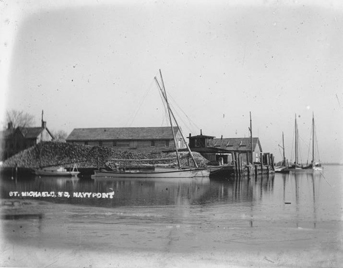 Pictured are the seafood businesses along Navy Point in 1907
Pictured are the seafood businesses along Navy Point in 1907
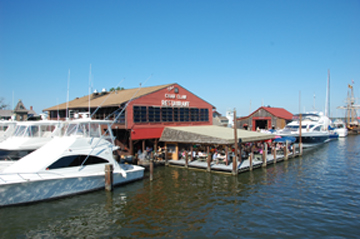 Pictured is the Crab Claw Restaurant today
Pictured is the Crab Claw Restaurant today
Photos Courtesy Chesapeake Bay Maritime Museum
Happy Anniversary, Crab Claw!
St. Michaels' most famed institutional restaurant is celebrating its 50th anniversary with a 1960s style party on May 22, from 4:30-9:30 p.m. To honor the milestone, there will be live music, Crab Claw trivia, door prizes and rollback prices on a drink and menu item popular when the restaurant open. Guests dressed in 1965 attire will receive a free drink.
While you're there, you can learn all about the Crab Claw's history, which includes a hefty list of famous patrons, including David Letterman, Neil Patrick Harris, Whoopi Goldberg and numerous political and sports figures. The restaurant has been owned and operated by the same family since its opening in 1965. For more details about the Crab Claw, or its anniversary celebration, call 410-745-2900, or visit
thecrabclaw.com.
May 19, 2015
Boatbuyer's Toolbox Aids New Buyers
When the boating bug bites, there's little stopping it. But knowing how and where to start a boat-buying search can be daunting for first-time (and even seasoned) buyers. To aid the uninitiated, BoatUS has devised a handy resource complete with helpful tips on where to find a boat, what to look for, buying a new vs. used boat, survey tips and more. The toolbox also covers after-sale aspects of boatbuying, including title, documentation and registration details, and a library of over 8,000 boat names for when you've bought your new baby. Check it out free at
BoatUS.com/buyer.
May 19, 2015
Blackwater National Wildlife Refuge Lands Best National Wildlife Refuge Designation
Readers of
USA Today voted Blackwater National Wildlife Refuge in Cambridge, Md., to its 10 Best Readers' Choice awards list of best national wildlife refuges. Blackwater came in at number 10, and was recognized for its internationally known birding area, its wetlands, and paddling and hiking trails.
May 19, 2015
Go Sailing, Win Some Swag!
As if you need an excuse to go sailing, the folks at Summer Sailstice have teamed up with charter giant, Sunsail, to offer sailors a little extra incentive to get out on the water for a summer solstice sail on June 20. All you need to do is sign up with Summer Sailstice at
www.summersailstice.com, and then go sailing! You'll then be entered to win the grand prize one-week BVI charter. Other prizes include several copies of CBM's own Guide to Cruising Chesapeake Bay, a standup paddleboard, a Velar SonarPhone or electronic charts from Navionics, a GoPro Hero3+, North Sails backpacks, gift certificates from J/Boats, a Spinlock Deckvest, a Ronstan Clear Start Watch . . . and the list goes on. Now, go sailing!
May 19, 2015
The Schooner Virginia under way.
Photo by Mark Krasnow Photography/Schooner Virginia
Schooner Virginia up for Sale
The Schooner Virginia, flagship of the Commonwealth, has been listed for sale. The 122-foot replica of a 1917 pilot schooner is listed with Sparkman & Stephens. The Virginia, was launched in 2005 to much fanfare and soon set a course record for the Great Chesapeake Bay Schooner Race. Funding for the Virginia's program fell out starting in 2008 when the economy took a dive. In 2009, she was taken out of commission due to lack of funds. In 2013 she was revived under a new business plan and renewed interest from donors, but soon operating costs outpaced contributions. The Virginia Maritime Heritage Foundation had been hoping to find a local buyer since fall, but has now listed it up on the national market with Sparkman & Stephens. Any interested parties can contact Harry Morgan at 203-687-4535 or
[email protected]. Questions about the Virginia can contact Will King at
[email protected].
May 12, 2015
Photo by Gary Reich
Crabs from Cans
If you've ever watched the hit HBO series
True Detective, then you probably remember the scene when Matthew McConaughey's lead character Rustin Cohle commanded his interrogators to fetch him a six-pack of beer in the middle of a police investigation. If you did, you likely remember him later cutting the emptied beer cans into stick figures with a pocketknife before staging each of them in various poses on the interrogation table as if they were Lego people.
It turns out Rustin Cohle isn't the only guy repurposing empty beer cans. We recently found an artist in Essex, Md., who makes life-size representations of the Chesapeake's infamous and grouchy crustacean-the blue crab-out of old National Bohemian beer cans. And these aren't any ordinary, boring crab silhouettes cut from flattened out pieces of aluminum. Not even close.
Travis Edmisten's crabs are the same size (and three-dimensional) as any seven-inch jimmy you'd find in a bushel of jumbos, and are almost as anatomically correct as the real thing-right down to the leg joints. Each "can crab" is made up of a six pack whittled down into 46 individual aluminum pieces that are then bent more than 140 times by hand. Edmisten even uses the bottom of the beer can and the pop tab as a hook, so the crabs can easily hang on a wall. Each crab takes about two hours to make by hand, from start to finish.
We asked Edmisten where this all got started. He says, "Well, I've been building stuff out of junk forever. I've made lamps out of pool balls and baseballs, tables out of playing cards, and even table lamps made from shotguns. But the crabs? Well, it sounds sort of cliché, but I got the idea sitting in front of the television one night watching an Orioles game. My mind is always running a couple hundred miles an hour, so after seeing all those folks drinking cans of Natty Boh I asked myself, 'I wonder what I could make out of those?' I started sketching, and after a few prototypes had one made exactly the way I wanted it." Edmisten strategically uses specific parts of each can so that "Mr. Boh's" one-eyed face shows on the can crab's carapace, claws and legs.
While the original National Bohemian can is Edmisten's most popular item, he makes his "uncanny" crustaceans from all sorts of brews: Budweiser, Bud Light, Coors Light, Yuengling, Duckpin, Birdhouse Pale Ale, Michelob Ultra, Miller Lite, Pabst Blue Ribbon. . . . Edmisten has also fashioned crabs from Coca-Cola, Orange Crush and various other soda cans. Each sells for $35.
"I've got plenty of friends who help keep me in cans," says Edmisten, adding, "They don't seem to mind throwing back a few to keep me busy." You can find Edmisten's creations at
etsy.com/shop/junkboxcustoms, or you might run into him at seafood festivals, art shows and other events around the Bay.
May 12, 2015
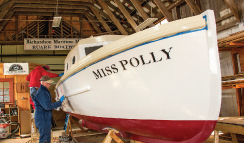 Photo courtesy of Cambridge Lighthouse Foundation
Photo courtesy of Cambridge Lighthouse Foundation
Good Golly Miss Polly
If you've cruised into Cambridge, Md., anytime in the last few years, you've likely noticed a stately new red-and-white screwpile lighthouse at the corner of the Cambridge Municipal Yacht Basin. That structure is an accurate replica of the lighthouse that stood off Benoni Point at the mouth of the Tred Avon River until it was dismantled in 1964.
In May, the lighthouse celebrated the beginning of its fourth season with a new addition:
Miss Polly, a full-scale wooden replica of a 22-foot dory, a boat much like the one that would have ferried the original lighthouse's keeper to and from shore. Volunteers at nearby Ruark Boatworks (a part of the Richardson Maritime Museum) in Cambridge built the boat over the last year, with the help of construction funds from the Pauline F. and W. David Robbins Charitable Foundation and the Heart of Chesapeake Country Heritage Area.
In addition to
Miss Polly, the lighthouse received a new fog bell and signal, as well as a fifth-order Fresnel lens, all of which are on permanent loan from the United States Coast Guard. Situated at the corner of High and Water streets in Cambridge, the lighthouse is open to the public daily (through October 31) from 9 a.m. to 6 p.m. for self-guided tours. Admission is free, but donations are welcome. Volunteers serving as "lighthouse keepers" are on duty Fridays, Saturdays and Sundays. For more information, visit
choptankriverlighthouse.org.
May 12, 2015
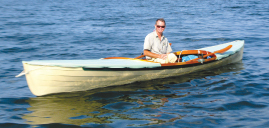 Photo by Andy Teeling
Photo by Andy Teeling
Long Journey's End
Last fall Andy Teeling of Belle Haven on Virginia's Eastern Shore completed a 450-mile rowing trip around the Delmarva Peninsula when he landed at the headquarters of the Chesapeake Bay Foundation in his hometown of Annapolis.
It was the end of a journey that was 35 years in the making.
In 1979, the 22-year-old Teeling dreamed of rowing a 16-foot home-built dory around the Delmarva Peninsula. With the help of the Chesapeake Bay Foundation, who provided many of the supplies he would use to record what he saw, Teeling set out in June from Annapolis and rowed south across the Chesapeake Bay, stopping at Fox and Watts islands and spending the nights in a tent rigged up with mosquito netting on his boat.
Averaging 10 miles a day, Teeling made his way south, rounding the tip of Virginia's Eastern Shore and proceeding northward in the Atlantic Ocean before ducking into the inlet waterway at Oyster.
By late August he found himself in Chincoteague, some 250 miles from his starting point. But it was time to return to college, so he hooked a ride with a waterman who took him and his boat to Crisfield, Md., where he rowed back home across the Chesapeake Bay and straight to the campus of St. Mary's College.
When college was done, he ultimately apprenticed with a master cabinetmaker, but other rowing adventures were on his mind, including a five-month stint rowing around Europe with his wife Caroline.
He built a 20-foot boat to handle two sets of oars. A friend who was a shipping agent found a captain willing to take the boat to Germany free of charge. When he and Caroline were ready to come home, they sold the boat to pay the airfare. They eventually came to the Eastern Shore, where they have raised two sons on 13 acres near Belle Haven. But something was missing.
"I always wanted to complete that journey I began thirty-five years ago," said Teeling, as he pondered a new project in his spacious workshop. "But life got in the way. Caroline and I were raising a family, and there was never enough time. I always had a map of the Delmarva Peninsula and the Chesapeake Bay in my shop, knowing I would complete the trip one day. Then this year my older son was in college, and the younger son was entering his senior year of high school, and we thought it was the right time to finish the trip."
On Memorial Day last year, Teeling, now 57 but not more than a pound or two over his 140-pound weight at age 22, set off from Chincoteague in another 20-foot double-ended skiff he built from a Francis Herreshoff design.
He rowed north through the inland bays, the Assawoman Canal and then the Lewes-Rehoboth Canal before entering the Delaware Bay and crossing into the Chesapeake via the 14-mile C&D Canal.
Blessed with excellent weather, Teeling made the 150-mile trip in 14 days, sometimes making as many a 18 miles in a day, though he paid the price with calluses as big as 50-cent pieces on both his hands. He stopped briefly at Still Pond Creek on Maryland's northern Eastern Shore, in order to return home to complete some orders for cabinets.
"Some things never change on the water," said Teeling. "Time has a way of slowing down when you're by yourself in a rowboat. It can seem like forever just to get to lunchtime. There is time to think, to reflect, to find a perspective on life-that is not easy to do in the world we live in today. In a rowboat a creek seems like a river, a river seems like a bay and the Bay seems like the ocean."
But Teeling said some things did change, and for the better. "Thirty-five years is a blink of the eye in history, and yet in that short time I've seen eagles where I used to see none. I've seen osprey by the hundreds where I used to see only a few. I've seen schools of rockfish swimming under my boat where I used to see none, and I've seen shoreline vegetation on the edge of farms when the fields once came right to the edge of the Bay."
He was pleased that beaches he had seen strewn with litter on that first trip were now clean. "It's amazing what a few thoughtful regulations have done for our shoreline."
To pursue his adventures, Teeling has made his life as simple as possible. There were no iPods or iPads on this trip, just a fishing rod to catch fish. "I find I need to be a minimalist to do what I do. I save every cent I can to be able to take off time from work. Then I take only what is essential on the trips. I only listened to a transistor radio twice a day to catch the weather report. And, over time, I was so in sync with nature I could almost predict the weather without having to listen. Planning is everything, but then you have to be ready for the unexpected."
Last October, Teeling completed the third and final leg of the 450-mile trip when he made the final 38-mile trek across the Chesapeake Bay to Annapolis. The next day, rather than load his boat on a truck for the ride home, he thought about rowing back to Belle Haven, but family and work obligations intervened.
He did the first 250 miles in one summer as a student whose love of the water and adventure spurred him to attempt what many would find unthinkable. He completed the second and third legs of the trip as a father, husband and master craftsman. At first reluctant to tell his story, Teeling said, "Maybe some young person will read this and think, 'Maybe I can build a small boat and take my own adventure.' "
Why not?
-Bill Sterling
May 12, 2015
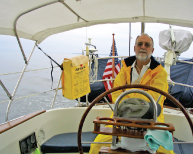 Photo by Arlow Sampson
Photo by Arlow Sampson
Boatkeeping Tip
It was early June, 2007. I was making my first offshore trip on
Wanderlust, our Dickerson 37, heading from Bristol, Rhode Island, to our first stop, Cape May, N.J., with my crew of three. We were approximately halfway, well off shore. It was 8 p.m. I was off watch and decided I should head for my bunk and try to get some sleep.
It was a beautiful evening. There hadn't been any wind for some hours so we were motoring. I had been doing occasional visual engine room checks since we left Bristol, so I decided to do one before I hit my bunk.
To my horror I found a steady stream of diesel fuel spraying across the engine room from the Westerbeke diesel. "Stop the engine!" I shouted. I couldn't imagine what was happening. There we sat with no means of propulsion, and to make matters worse, and we are in the vicinity of three sets of shipping lanes out of New York.
Fairly quickly I was able to determine that the fuel had been coming from the fuel-filter housing downstream of the lift pump. I had changed the filter just prior to leaving Bristol and hadn't noticed any problems. The bowl of the filter housing was held in place with a large aluminum nut with fine threads. As soon as I touched the nut, it was apparent that it was loose and the threads were stripped. You could hand tighten it up to a point and then it just spun.
I always carry a large supply of materials for use in emergencies, so I tried to figure out what I had that I could use for a repair. One of my favorite products is blue Loctite, and I thought this would be the easiest thing to try first. With the bowl disassembled I wiped the threads with a rag, coated them with Loctite and reassembled the bowl. I tightened the nut just to the point where it felt like the threads were starting to slip.
We left the engine off for approximately fifteen minutes. (While waiting I tackled the cleanup process. What a mess!)
When we started the engine again, we were relieved to see no leak, so off we went toward Cape May. For the rest of the night we kept a close watch on the filter housing not knowing how long the repair would last. By morning it was apparent that the fix was successful, still no leaks!
Three days later me made it to Oxford, Md., in time for the Dickerson Rendezvous, without leaking a drop. For me the moral of the story is, don't leave home without blue Loctite.
Thanks to Captain Arlow Sampson, aboard
Wanderlust (pictured above).
Send your boatkeeping tip (long or short, but we're suckers for a good story) to [email protected]. If we print it we'll send you a Chesapeake Bay Magazine hat.
May 12, 2015
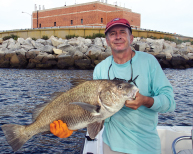 Photo by Gary Reich
Photo by Gary Reich
Is It a Keeper?
There's not a lot worse than being stopped and boarded by marine law enforcement only to find out that the 35-inch cobia in your fishbox-the one you thought was a keeper- actually needs to be two inches longer.
The Virginia Marine Resources Commission (VMRC) is hoping to keep you on the up and up this fishing season by enhancing its mobile-friendly website. The new website is easily accessible on mobile devices, such as smartphones and tablets, which means more anglers can quickly and easily find season, size and creel regulations for the fish and crabs they catch in Virginia waters. The site also has information on current state record and citation sizes for each species listed. You can access the site on the water anywhere there's cellular data coverage by visiting
mrc.virginia.gov/mobile with your Android or iOS devices.
May 12, 2015
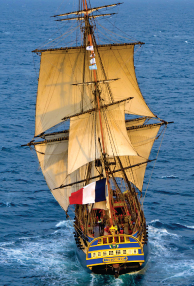
June is L'Hermione Month on the Bay
CBM readers may remember our
Talk of the Bay story from the January/February issue, where we wrote about a very special French tall ship getting ready to set sail across the vast Atlantic Ocean for the Chesapeake Bay and five port towns along its shores. That ship is
L'Hermione, a replica of a vessel that carried Major General Lafayette to America back in 1780.
The 213-foot
L'Hermione set sail from the mouth of the River Charente, in Port des Barques, France, in April. This is the same place where Lafayette boarded the original
L'Hermione on March 10, 1780, bound for America.
L'Hermione stopped in Las Palmas in the Canary Islands before setting off on her transatlantic voyage to Yorktown, Va., where she is scheduled to arrive June 5. After Yorktown,
L'Hermione will sail on to Mount Vernon, Alexandria, Va., Annapolis and Baltimore, before heading to Philadelphia and several other ports all the way up into Canada's Maritime Provinces.
The initial transatlantic landing point of Yorktown is significant in that Lafayette and
L'Hermione participated in the Siege of Yorktown during the American Revolutionary War. It was a decisive battle in which Lafayette organized targeted attacks against British supply units and L'Hermione participated in a naval blockade that squeezed British troops to the point of surrender.
The voyage is a celebration not only of the ship, but also of Marie-Joseph Paul Yves Roch Gilbert du Motier, known more familiarly as the Marquis de Lafayette, the man who volunteered his services to the Continental Army during the American Revolutionary War. Visit
hermione2015.com for the full story and a further itinerary of her activities.
May 12, 2015
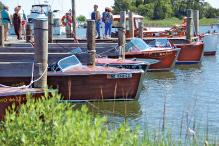 Photo courtesy of CBMM
Photo courtesy of CBMM
Classic Craft Invade St. Michaels for Father's Day Weekend
"There's nothing as nice as a beautiful wooden boat. Wood's got soul-it's a living, breathing thing. I can tell the sound of a wooden boat when I hear it coming, because of the acoustics of the hull resonating through the water. It's like a guitar going down the river." If that quote from my friend George Hazzard, of Wooden Boat Restoration in Millington, Md., resonates with you, you'll definitely want to clear a day from your calendar on June 19, 20, or 21. If you've really got a case of old boat affliction, clear the whole weekend.
That's when more than 100 beautifully restored wooden boats and all sorts of antique boating gear, nautical arts and crafts, and craftspeople will roll into the Chesapeake Bay Maritime Museum (CBMM) in St. Michaels, Md., for the 28th installment of the Antique & Classic Boat Festival. And it doesn't matter if you don't know the difference between a Chris-Craft and a Hacker Craft; if you appreciate the fine beauty of those glossy old mahogany or teak beauties, be there or be square.
Once you've arrived you'll find static displays of gleaming boats scattered on land across CBMM's campus, as well as in the water at the museum's Fogg Cove docks. Boat types range from hydroplanes to runabouts and workboats to motor yachts. Be sure to check out the expansive displays of restored outboard engines, some of which date back several decades, but also set aside time to walk through the tents and check out the tons of unique local artwork and crafts. I find a crafty treasure among the tables every year I attend.
Festival hours are Friday, June 19, 11 a.m.-5 p.m.; Saturday, June 20, 10 a.m.-5 p.m.; and Father's Day, Sunday, June 21, 10 a.m.-2 p.m. The festival includes admission to all museum exhibitions where authentic Chesapeake boats, cultures and traditions are highlighted. Admission is good for two consecutive days: $18 for adults, $15 for seniors and students with ID, or $6 for children 6 to 17. Entry for museum members and children under six is free. For more information, visit
cbmm.org/acbf.
May 12, 2015
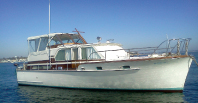 Photo courtesy of MBOA
Photo courtesy of MBOA
Matthews Owners Rejoice
Okay, it's not exactly couch potato weather outside, but we think we've found a worthwhile evening or weekend watch, especially for Matthews Boats owners and enthusiasts.
The Heritage & Evolution of Matthews Boats is a new production that details the story of the Matthews Company, which built hundreds of beautiful wooden and fiberglass powerboats from 1898 to the early '70s. Narrated by Bob Reynolds, grandson of Matthews Boat founder Scott J. Matthews. $15 ($10 for MBOA members) from
matthewsboatownersassoc.com/merchandise.php.
May 12, 2015
Gentlemen, Start Your Engines
The waters of Hog Bay will turn into a frothed-up display of water-shredding horsepower when Thunder on the Narrows kicks off June 27 for its 25th running. And if hopped-up hydroplanes shooting rooster tails high into the air, or Jersey Speed Skiffs carving turns at speeds that seem just on the edge of disaster sound good to you, make plans to head to Kent Narrows for a good dose of shock and awesome. The event wraps up the afternoon of June 28.
The races start and finish in Hog Bay, which is nestled behind the Kent Island Yacht Club (KIYC) just off the east side of Kent Narrows on the northern end of Prospect Bay. The best views of the racing oval are in and among the lively anchored spectator fleet, but make sure you stay well outside the anchored warning buoys, which mark the boundaries of the race course. The best spots on the water go quick, so arriving early each day is the key to getting a good spot. You'll see various hydroplane classes and Jersey Speed Skiffs duking it out at speeds up to 140 mph.
You can also enjoy the action from land, thanks to the hospitality of the folks at KIYC. There are a few catches, however. First, leave coolers and beverages at home; you won't be allowed on the grounds with either. Luckily, though, there are lots of great and reasonably priced food and beverage options. We recommend a cold one and a pit beef sandwich. Also, no parking is allowed on KIYC grounds. By automobile, take Exit 41 off U.S. Route 50, and then follow the signs to the designated parking areas. Free shuttle buses will take you the short distance to and from the yacht club, where adults pay $7 to get in (kids 12 and under are free). Gates open at 10 a.m. each day; the racing action blasts off at noon. Click over to
kentnarrowsracing.com/events.php for the scoop.
May 12, 2015
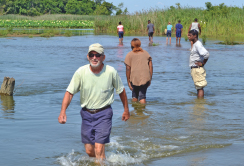 Photo by Sean Lyons
Photo by Sean Lyons
Ex-Congressman Heads for the Trenches
Spry at 69, Gilchrest canoes, hikes, fishes and plants trees with youngsters anxious to learn. They numbered more than 1,000 this school year, an eight-fold increase since he helped open the Sassafras Environmental Education Center in 2010.
With the facility's only other staffer, marine biologist Jaime Belanger, Gilchrest teaches such subjects as stream restoration, water and soil ecology, pollution control, photosynthesis, the food chain and about English explorer John Smith's exploits four centuries ago in a very different Chesapeake Bay.
"I see this as an educational oasis for children where they can learn their place in the ecosystem and develop an appreciation for nature," says Gilchrest. "And they have fun doing it."
Students keep on the move. They ask watermen about their work, examine shells and bones of wild animals and, in a lesson on farming and community service, plant and dig up potatoes that they deliver to the Kent County Food Bank.
The center sits on 1,000 acres of county- and state-owned land along the Sassafras River, a blend of old-growth forests and agricultural fields with an abundance of wildlife.
It operates in a partnership with the Maryland Department of Natural Resources, the Eastern Shore Land Conservancy and Kent County public schools, which provide most of the students, grades two to ten. Gilchrest intends to expand it to include grades 11 and 12, as well. Its tuition? Free.
Like many former U.S. lawmakers, Gilchrest received offers to join corporate boards or lobbying firms when he left Congress in January 2009, after 18 years of service.
"But I was done wearing a suit and going to boring meetings," he said. So Gilchrest began the center, motivated largely by what he saw in Washington. "I had colleagues who knew nothing about environmental issues-whether it was good farming practices, climate change or wildlife habitat-yet they had absolute certainty about what they believed in, which was anti-environment. I guess they didn't learn an appreciation for the environment, especially when they were young."
Gilchrest thought that if he could build an outdoor school in a beautiful spot like this, where he could teach children about environmental issues, he could literally change their pattern of thinking. "They would get out of high school with a pretty good frame of reference about how to be compatible with nature's design, upon which they depend," he said.
In Washington, Gilchrest was a member of a vanishing breed, a moderate Republican maverick who broke ranks with party leaders. It cost him his job. He was voted out in the 2008 Republican primary in favor of a conservative, Andy Harris.
Gilchrest now has a beard, wears blue jeans and drives a pickup truck. His office is in an old brick building near Turners Creek, just outside of Kennedyville.
While students call him "Mr. Gilchrest," others in town refer to him simply as "Wayne."
"Nobody calls me 'Congressman' anymore," he says. "That's over. I don't miss it. I have no sense of it."
Gilchrest recalls, however, co-chairing a bipartisan congressional caucus on climate change and being unable to drum up interest among fellow lawmakers.
"We invited them to meetings with some of the nation's top scientists. We brought in food. But they wouldn't come. They didn't get it."
Gilchrest's students "get it."
"They dig in the dirt," he says, "walk in the woods. They are outside, and they are learning all the time."
-Thomas Ferraro
May 12, 2015
wwwDOT: Tides
It's pretty clear that Brutus was a Chesapeake Bay sailor who encountered a few sandbars in his time: "There is a tide in the affairs of men, which, taken at the flood, leads on to fortune. . . ."
(Julius Caesar Act 4, scene 3)
Besides telling when you will be able to float off a shoal or get out of your marina slip, tide information shows where you will be able to anchor for the night and implies what the currents will be doing to help or hinder you on the way.
Since the moon creates the rhythmic earth-size wave movements we call tides, calculating them is predictable, although the effects of shoreline shape, depth and wind complicate things significantly. It was one of the first nautical phenomena to be computerized, and David Flater's
Xtide (
www.flaterco.com/xtide) is still the basis for many newer programs with snazzier interfaces.
You can get tide and current information easily on your desktop or laptop computer, even by e-mail. All the standard commercial chart plotting software includes it as a matter of course. The Mother Ship for tide and current information is the U.S. Government (
co-ops.nos.noaa.gov/faq4.html). Start here for all the essential information.
But we live in an age of mobile devices-iPads, smart phones and whatever else the hardware gnomes are assembling in their caves today. There are several excellent apps for tide and current information for our mobile toys and many are free.
Note that many of these apps require a data connection, either a Wi-Fi link or a cellular phone connection, to work. That's a real drawback on a boat since we are often out of range of these links. I recommend choosing an app that works independently of shore connections.
Friends recommend
AyeTides (
ayetides.com) as the best app of all. It's $7.99 and runs only on iOS hardware (iPhone, iPad and iPod Touch).
Tides & Currents (
www.amazon.com/Flytomap-Tides-Currents/dp/B008RWOCQ6) is the equivalent for Android. It's free but there seem to be some compatibility issues with certain devices.
TideApp (
www.tideapp.com) looks like a good one for all platforms, and it is free. The developer was working on offline access and it may be included by the time you read this.
For a quick look at the entire field, go to
AppCrawler (
appcrawlr.com) and explore the possibilities by searching for "tide prediction." Download and try out anything that rates three stars or better and looks interesting. All should be pretty accurate; your preferences for layout, colors and controls will be a deciding factor, too.
-Tom Dove
May 12, 2015
 Photo by Zora Aiken
Photo by Zora Aiken
Rivah Markets
Cruisers look forward to shore stops that resupply fresh foods, and three near-shore locations along the Rappahannock put fresh veggies within easy reach. Besides the seasonal produce, there may be pork or bison from Northern Neck farms, local honey and specialty sauces, and wonderful baked goods, from scones and breads to fancy desserts.
Nowadays, there's so much more to a Farmers Market than healthy produce. Arts and crafts of every stripe find their way to market, promoted by ambitious entrepreneurs who arrive shortly after dawn to pop their E-Z Up tent and offer their hopefully "e-z sell" goods. Baskets, jewelry, woven goods, leaded glass, garden art-all find a place, including the two alpacas who attract buyers to all the items made from their super-soft, super-warm wool. Christmas shopping anyone?
The markets are open from 9 a.m. to 1 p.m. The first Saturday of each month (May through November) belongs to Irvington, located on Carter's Creek just off the Rappahannock a short distance west of the Route 3 bridge. Stay on the main branch of the creek to marinas or a yacht club on the starboard side, or find a handy place to anchor. (Check with Rappahannock Yachts about leaving the dinghy.) Walk up Carter's Creek Road to King Carter Drive, and go left till you see the tents at Irvington Commons. Just so you know: The Irvington Market has the distinction of being voted the Best Farmer's Market on Virginia's East Coast according to
Virginia Living Magazine.
The second Saturday of the month is the Urbanna Market, up the river a few more miles and on the opposite shore. Anchor in the creek or stay at one of the marinas; it's an easy walk to Taber Park, where the Market sets up. Walk into town (Virginia Street is the main road), turn right at Rappahannock Avenue, and see the park on the left. On the way back you can stop at any of the town's shops or restaurants, many of which are conveniently lined up on Virginia Street.
On the fourth Saturday, stop at Deltaville's Market, held on the grounds of the Deltaville Maritime Museum/Holly Point Nature Center on Mill Creek. Nearby Jackson Creek has a marina and anchorage; the crew can either take the dinghy or walk to the museum, which is on Jackson Creek Road. There's a dock at the museum where visitors can leave the dinghy while wandering around the market. A look around the newly rebuilt museum is a plus.
-Zora Aiken
April 22, 2015
Notices to Chesapeake Mariners
Elizabeth River partial channel closures for tunnel construction
There is good news for boaters planning to transit the Elizabeth River this month. A few weeks ago, the Coast Guard announced that the Elizabeth River channel would be closed to all traffic for 48 hours at a time over several days during construction of the Midtown Tunnel. This would have put up a serious crimp of in the plans of returning snowbirds, commercial traffic and local cruisers. But this week, SKW Construction announced that instead of closing the channel, they would narrow to 375 feet.
Project manager Terry Cronk told CBM on Tuesday, April 21, that he was about 97 percent certain that all of the construction in the area would now be done by narrowing, rather than closing, the Elizabeth River channel. The next full closure on the schedule is April 27, but Cronk said that date too likely will be modified. We'll have a more definite idea of the coming schedule later this week.
No more printed Light Lists
Coast Guard Light Lists are a means for communicating aids to navigation information to the maritime public. Effective immediately, the Coast Guard will no longer print hardcopy Light Lists. The last government printed Light Lists were the 2014 editions.
Based on emerging technology and the ability to update Light Lists on a weekly basis, the cost and time for printing the Light List on an annual basis has reached obsolescence. Technology now allows us to provide the Light List in a timelier and less costly manner via the Internet. A Federal Register Notice announcing this change was issued on 1 April 2015. The notice can be viewed at http://www.gpo.gov/fdsys/pkg/FR- 2015-04-01/pdf/2015-07501.pdf.
Electronic Light Lists are available on the Coast Guard Navigation Center's (NAVCEN) website at http://www.navcen.uscg.gov/?pageName=lightLists. Complete versions of the Light Lists are updated weekly on the NAVCEN website at http://www.navcen.uscg.gov/?pageName=lightListWeeklyUpdates. Mariners should download applicable copies and updates as needed. Electronic nautical publications are authorized for use on commercial vessels. While the Light Lists will no longer be available in government printed form, commercial reproductions may be available in the future. Local Notices to Mariners will continue to advertise Light List corrections and NAVCEN will continue to publish a compilation of corrections.
Coast Guard proposes extinguishing Wolf Trap light
Wolf Trap Lighthouse (LLNR 7255), which is privately maintained, has been deemed unsafe for Coast Guard personnel to access. The Coast Guard is soliciting comments on discontinuing the lighting equipment on Wolf Trap Light. Interested Mariners and other stakeholders are strongly encouraged to comment on the potential impacts this proposal would have on navigational safety. You may provide feedback using the U. S. Coast Guard Fifth District Waterway Data Sheet, available online at http://www.navcen.uscg.gov/pdf/lnms/D5_LNM_2014_Special_Notice_Waterway_Proposal_Feedback_Form.pdf.
All comments will be carefully considered and are requested prior to May 25, 2015 to be considered in the analysis. Refer to project number 05- 15-073(D) Send comments to
[email protected] or
[email protected], or mailed to U.S. Coast Guard Fifth District
Waterways Management (dpw) Attn: Albert Grimes, Room 100 431 Crawford Street Portsmouth, VA 23704.
Charts: 12225 12238
Patapsco River: Update on closure of CSX Railroad Bridge on Curtis Creek
Mariners are advised that the CSX Railroad Bridge, at mile 1.3, across Curtis Creek, in Baltimore, will continue to be maintained in the closed-to-navigation position to facilitate railway tie work. The closure period will continue from 11 a.m. to 4 p.m. on Mondays through Thursdays until May 8. The bridge will still be able to open for navigation with advance notice by contacting 410-916-5045 or on VHF 13/16. At all other times, the drawbridge will operate in accordance with the operating drawbridge regulations set out in Title 33 Code of Federal Regulations Part 117.5 Mariners should adjust their transits accordingly. Chart 12289
Artificial reef construction off Love Point
On or about April 27, Corman Marine Construction, Inc. in association with MD DNR Artificial Reef Program, will be placing 1,350 tons of concrete columns and slab in the Southeast Quadrant of the Love Point Fish Haven. The 15-foot clearance will be maintained. Center Location: 39 04 05.42N-76 17 27.37W. Charts: 12278 12281
Bush River landing-craft operations
The U.S. Naval Surface Warfare Center, Carderock Division, will be conducting Landing Craft Air Cushion (LCAC) operations between noon and 4 p.m. on April 27, and between 7and 10 a.m. on April 30. Operations consist of multiple LCACs transiting the Bush River between Bush River Lighted Buoy 3 (LLNR 27315) and Buoy River Wreck Light WR7 (LLNR 27340). The LCACs can be contacted on VHF Channel 13. Chart 12274
April 20, 2015
From Snapshots to Selfies
In honor of its 50th anniversary, the Chesapeake Bay Maritime Museum in St. Michaels, Md., is asking for Bay denizens to share photos for its new exhibition called "Snapshots to Selfies: 50 Years of Chesapeake Summers." The museum will be accepting photo submissions from May 23 to November 30, 2015, and the exhibition will open in 2016.
"We want to celebrate that sense of community for our 50th anniversary in a meaningful way. This exhibition is a great way for people to share their favorite family or personal memories of time spent on the Chesapeake's waters. And when the exhibition is complete, the photos will share an interwoven story of the meaningful ways people have connected with the Bay over these last 50 years," says museum president Kristen Greenaway. To that end, the museum wants pictures of people fishing, boating, swimming or just enjoying a day on the Chesapeake with friends and family. Says CBMM Director of Education Kate Livie, "The beautiful images in this exhibition won't be landscapes or sunset shots. Instead, they'll be all of us, making memories during the summertime in the Chesapeake."
Visit
www.cbmm.org/snapshots for details on how to upload your pictures. The museum will also offer several opportunities throughout the summer at which you can scan your old photographs, beginning May 23 at the Party on the Point anniversary celebration.
April 20, 2015
Photo courtesy Mid-Atlantic Aerial Video Photography. All 18 acres of the Chesapeake Bay Maritime Museum in St. Michaels, Md., will be available for free to all active duty, National Guard, and Reserve military personnel and their families between May 25 and September 7 this year.
Thank You for Your Service
Freedom may not be free, but those who fight for our freedoms-and the family members who support them-can enjoy complimentary admission to the Chesapeake Bay Maritime Museum (CBMM) this season as part of collaboration among the National Endowment for the Arts, Blue Star Families, and the Department of Defense. Along with more than 2,000 other museums across the United States, CBMM will offer complimentary admission to its 18-acre campus and 12 exhibition buildings for all active duty, National Guard, and Reserve military personnel and their families between May 25 and September 7 this year. It's easy, too. All active-duty military personnel and their immediate family members have to do to get in is show a military ID upon entry. To learn about CBMM and its programs, visit
cbmm.org.
April 20, 2015
Spring Sailboat Show Brings New Regatta
Six area high school sailing teams will participate in the inaugural spring high school invitational keelboat regatta. The regatta will take place April 24-26 in Annapolis, with regatta events at City Dock in conjunction with the Annapolis Spring Sailboat Show going on that same weekend. The high schools participating (all local to Annapolis) are: Severna Park High School, St. Mary's High School, Severn School, Broadneck High School, South River High School and Archbishop Spalding. The teams will sail J/80s from Annapolis's J/World sailing school and will compete for the Weems & Plath-designed traveling cup.
All races will be run on Saturday, April 25, starting at noon. An Award ceremony will take place in Susan Campbell Park at 3:30 p.m. For more information, call 410-268-8828 or visit
www.annapolisboatshows.com.
April 9, 2015
Photo courtesy VIMS
75 Years of VIMS
There's history under your feet here. You can just about feel it. On the 40-acre campus of the Virginia Institute of Marine Science (VIMS) at Gloucester Point on the York River, artifacts of Indian settlements and a once-thriving colonial village, Gloucestertown, have been unearthed. The point also witnessed the last gasp of British rule as General Cornwallis attempted a desperate nighttime crossing from Yorktown only to be thwarted by a thunderous squall and forced to surrender.
The Virginia Fisheries Laboratory, as it was first called, was born in 1940 in a converted gas station on the Yorktown side of the river. The initial budget was $12,000. Ten years later, the lab moved to Gloucester Point, changed its name, became part of the College of William & Mary and began growing into the today's far-flung research and academic institution, with a budget of $43 million and a population that includes 60 faculty and 100 marine science graduate students.
Now VIMS is celebrating 75 years of monitoring the health of the Chesapeake Bay and finding ways to improve it. Scientists who work and teach here are grappling with the new realities of the Bay-population growth and rising sea levels-and how to make the best of these conditions.
"The good news is that a lot of progress has been made," Mark Luchenbach, associate dean of research, told me. It was a cold, blustery January morning, and yet, outside his window, a deadrise fishing boat was shrugging off waves as it bustled by on the York. The fisherman, I was thinking, owes the size of his catch to the research VIMS has conducted on the health of various species on the Bay and coastal waters. "The bad news," Luchenbach said, "is that all the easy stuff has been done. The rest is pretty much all heavy lifting."
The easy stuff involved curbing raw sewage, construction runoff and excess fertilizer. Heavy lifting? That would be hefting the problems of agricultural runoff, non-point pollution, advanced sewage treatment, population pressure and that silent thief, sea-level rise.
With a mandate from the Commonwealth to bring the best science to bear and make recommendations about the health of Virginia waters and the seafood industry, as well as to educate students, VIMS began long-running studies on oysters, blue crabs, juvenile fish and sharks. Soon its scientists were influencing the creation of national programs like "sea grant" college funds and coastal zone management. They prompted an impressive seagrass restoration effort. They opened labs on the Eastern Shore that sparked a resurgence in the clam industry. Their facilities on the Rappahannock River spurred the growth of farm-raised oysters. VIMS reaches to the bottom of the Bay with scuba divers and into space with satellite tracking of migrating species. Throughout the year, research boats monitor the health of finfish and blue crabs. Now VIMS has gone global, sending scientists to both poles, the Arctic and Antarctic, to help study climate change and its relation to estuaries and coastal waters. From molecular to global, its literature says. From mighty rivers to the deep blue sea.
"We have scientists working now on every continent in the world," Luchenbach writes in a new report on VIMS's 75-year history. "They're not only parts of teams; they're leaders of international teams. And it's not just us exporting our ideas to other places. We're bringing knowledge from these collaborations to bear on local issues."
VIMS has gone high tech in a big way, including its Bridge online marine science education programs. Just a glance at the website (
www.vims.edu/bridge) reveals teacher-approved K-12 lesson plans, including this one for kindergarten: "Don't eat your flatfish before they're counted."
VIMS has been around long enough to observe many of the changes in the Bay's ecology. I went to see Carl Hershner, director of VIMS's Center for Coastal Resources Management, who has been there since 1971 and was preparing an "After Hours" lecture on "The Chesapeake Bay, Past, Present and Future." Here's a quick take of the Bay's various stages, according to Hershner:
When the English first arrived, he said, sturgeon and shad abounded; as towns and taverns appeared, the characteristic species were oysters and rockfish; with cities and suburbs on the rise, the shift was toward crabs and menhaden; not far off, if megalopolis is where we're heading, he says, the predominant critters are likely to be jellyfish and algal blooms. Not exactly what you'd put on the table.
Changes in the Bay are inevitable, Hershner told listeners at the lecture. "The thing to keep in mind is that we're not going back to where we were. . . . We've got a lot more development and a lot more people, and the climate is changing. And so that means our opportunity to change the system is changing constantly."
For instance, he said in an interview, the conventional wisdom about limiting development has been to build up to the back edge of marshes. "But what we didn't anticipate was the fact that as the climate changes and the sea levels rise, the marshes need to move." In many cases development stands in the way and the marshes give way.
Over more than four decades, Hershner has seen the Bay go from bad to better because of educated management efforts. The fact that it seems to be stalled now because of inevitable forces doesn't make him want to give up. "The future to me is pretty exciting," he said, "because I still believe that we can have a natural resource that we can derive a lot of benefits from. But they're just going to be different benefits from what we had in the past."
John Wells, VIMS dean and director, put it this way in the introduction to the new VIMS 75th anniversary report, "As we reflect on our history, it's clear that now, more than ever, our tagline is most fitting: Science for the Bay, Impact for the World. Our new Strategic Plan will carry us forward as a marine science institution with high impact." And, in a nod to all that history, he added, "Our success is a tribute not only to the people who work and study here, but to those who came before us and on whose shoulders we stand."
-Paul Clancy
April 9, 2015
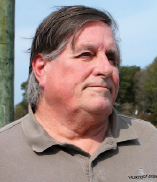 Photo by Bill Sterling
Photo by Bill Sterling
New in Onancock
When Superstorm Sandy barreled through Onancock in 2012, she took out the then nearly new harbormaster's office (among other things), leaving transient boaters to cope with minimal portable facilities until a new welcome mat was ready and operational. Last spring, the new building opened, complete with private showers, a spacious complimentary laundry room, a transient pump-out station and an ice-and-soda machine. Also new last year was harbormaster Charles Kelly, a native of the area who returned to the Eastern Shore of Virginia after a career that included positions as a computer scientist at the National Science Foundation and a regional director for Microsoft.
Among other new touches, Kelly has upgraded the marina's presence with an enhanced website (
onancockmarina.com) and a Facebook page (Onancock Town Wharf). "Since my background is in computers, I'm interested in social media and interact with boaters through a variety of ways," he says. "Our webpage includes reviews and thoughts from many of our visitors. Plus we've got over a thousand photos so boaters can get an overview of the marina and town." WiFi service is available for boaters and will improve once a planned broadband system reaches the area.
Onancock is a quiet, tranquil place to visit, Kelly says. The four-mile ride from the Bay to the harbor includes beautiful landscapes, historic homes and is easy for boaters to travel with seven to 10 feet of water up to the harbor and 12 to 14 feet in the channel. An easy stroll brings visitors to the heart of town where they'll find good restaurants (there is also a dockside restaurant), interesting shops, art galleries and lovely old Victorian homes.
For more information or to make reservations, contact Charles Kelly at 757-787-7911 or email
[email protected].
-Bill Sterling
April 9, 2015
Angels on the Bay
What sets off car alarms in a 10-mile radius, shakes folks out of their office chairs, and is a blast to watch from the water-or close to it? Why the U.S. Navy's crack flight-demonstration team, the Blue Angels, of course. The group of six, navy-blue Boeing F/A-18 Hornets will return to Annapolis for the United States Naval Academy's (USNA) Commencement Week activities this year, culminating in a formation flyover at the Class of 2015's commencement ceremony at the Navy-Marine Corps Memorial Stadium at 10:04 a.m. on May 22.
But the day to play hooky from work, untie the boat and head to Annapolis is May 20, when the team will provide a stunning, thundering, acrobatic aerial display in the skies above the Annapolis Harbor and surrounding waters. The show kicks off at 2 p.m., and generally runs about 30 to 40 minutes. The best vantage point, in our opinion, is just off the USNA seawall in the designated anchoring area between Triton and Horn points, but you can also get a decent view from Annapolis Harbor, and Spa and Back creeks. Those poor souls without a boat can get great views from the USNA grounds, but keep in mind that a government-issued ID is required and lawn chairs and coolers are generally prohibited.
While the team does execute practice flights the day before the premier event, the time of arrival for these flights is unspecific (sometime between 11 a.m. and 1 p.m., and again at 2 p.m.), and they might not execute all of their maneuvers. To get the scoop on the Blue Angels show and all of the USNA's Commencement week activities, visit
usna.edu/commissioningweek.
April 9, 2015
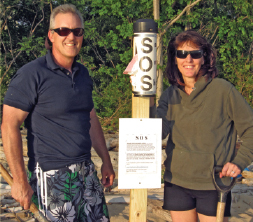 Photo by Donna Haley
Photo by Donna Haley
Save Our Shores
Concerned about trash piling up on nearby beaches, Mark and Donna Haley, of Jarrettsville, Md., decided to do something about it. They set up their first Save Our Shores dispenser in 2011, providing trash bags to visiting boaters and encouraging them to help with the clean-up effort. Since then they've established three sites altogether: Fairlee Creek Inlet and north and south of the Worton Creek entrance. "We dispense over three hundred trash bags per season," Donna writes, "and we've seen a significant reduction in the trash along our beaches. We generally install the dispensers in mid-April and remove them by mid-September." If anyone wants to set up similar dispensers in other locations, she adds, feel free to contact her at
[email protected].
April 9, 2015
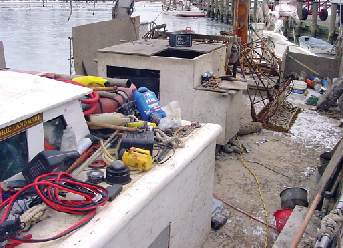 Photos by Gary D. Crawford
Photos by Gary D. Crawford
A Fleet, Once Again
Oyster season is over now, but one day back in early February, when a strong northwest wind was lowering the windchill and shoving the water out of the Bay, our oyster fleet was out in the river. After all, this was oystering weather.
Once home to a whole fleet of dredgeboats, Tilghman had dwindled down to two: the
Rebecca T. Ruark (Captain Wadie Murphy) and the
Thomas W. Clyde (Captain Lawrence Murphy). Then last year, Captain Wade Murphy III (Wadie's son) brought in the
Hilda M. Willing, increasing the island fleet to three. That may sound like small potatoes, but keep in mind that fewer than a dozen skipjacks are still operating anywhere on the Bay.
For several winters now, Captain Lawrence dredged down the Bay to Tangier Sound and the waters off Deal Island, along with most of the other remaining skipjacks. Last winter, Captain Wadie tried the Choptank River, around the mouth of the Tred Avon and Castle Haven. He had to be careful, though, because large areas there have been designated as no-oystering zones. The Maryland Department of Natural Resources (DNR) had supplied him with a map showing the location of the forbidden areas, but it lacked navigational reference. It was just lines on a map.
He asked for some help. "You do all that computer stuff," he said. "Can you put this map on top of a navigational chart?" He said he wanted to obey the law, but wasn't just where the DNR lines ran in relation to the buoys and markers out in the river. And being a Tilghman Islander, he knew he'd be slapped with a fine (or worse) if he strayed even a few yards over their imaginary line. I agreed, so we scanned the map and the chart, superimposed the map over the chart, matched up the shorelines, and printed out a page for use on the
Rebecca.
This year some oyster beds around the mouth of the Choptank were making a comeback and (amazingly) were not in an oyster sanctuary, so all three Tilghman boats were staying put. But on this February day, I was in for surprise. I counted four (!) masts in Dogwood Harbor. Captain Ed Farley had come down from St. Michaels and joined the fleet with the
H. M. Krentz.
After dashing home for my camera, my wife and I drove back to the harbor where I got a few shots. The Rebecca looked very unlike the pristine beauty she is in the summertime when Captain Wadie takes folks out for a sail and a chat. She looked like a working boat, a Chesapeake drudger, her decks temporarily cluttered and rusty gear everywhere.
As I walked over, Captain Wadie was lugging a big boat propeller off the Rebecca. His opening line was, "How much do you think one of these costs?" I guessed $800; he said, "Nope, fifteen hundred!" A line had gotten fouled in the prop of his yawl boat. It wound itself up and yanked the yawl boat partly out of the water, throwing his crewman ten feet in the air and out into the frigid water. The man got back aboard okay though he was mighty cold. Captain Wadie threw the damaged propeller into his pickup.
He asked if we'd like some oysters. He dug around in the hold then handed me a couple dozen in a plastic bag. "They're frozen, now, so let 'em thaw before you start on 'em." Then he waved and climbed back aboard.
-Gary D. Crawford
April 9, 2015
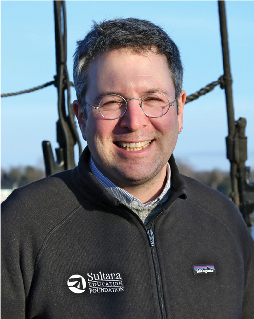 Photo by Wendy Mitman Clarke
Photo by Wendy Mitman Clarke
Welcome Aboard!
Michael Fiorentino, who has captained the schooner
Lady Maryland for the last four years and served as chief mate and carpenter aboard
Pride of Baltimore II, in February became the new skipper of
Sultana in Chestertown. The change came when Tanya Banks-Christensen stepped down after seven successful years as
Sultana's captain, saying it was time for new adventures.
Fiorentino, who holds a 500-ton Master of Oceans license, is the most experienced person ever hired to run the
Sultana, the Sultana Foundation noted in a press release. He's also a highly regarded educator.
Fiorentino says he's thrilled to become part of a strong community-based organization that is rapidly expanding, including construction of a new LEED Platinum-certified education center slated to break ground this year and be completed by early 2016. "I am really excited to be part of that core team that is developing the program and moving it forward," he says.
He's also excited to spend more time on the Chesapeake and take
Sultana to places where the deeper-draft
Lady Maryland and
Pride could never go. "I've never spent the summer on the Bay," he says. "It's going to be hot, but I'm ready! And I'm excited to see more and have more time to explore the Bay."
The new captain will also bring his buyboat, the 82-year-old, Deltaville-built
Marion M, to the Eastern Shore where he plans to restore her. Worked until 1999, she was purchased by South Street Seaport, but the museum was unable to use her. "I picked her up for the right price-a dollar," Fiorentino says.
Fiorentino began his career as a theater and set design engineer in New York City (he graduated from New York University's Tisch School of the Arts). He became a schooner captain when the design firm he was working for took on a boat project for a museum. "I thought that was pretty cool," he says. "I knew a lot about carpentry, but I didn't know anything about ship's carpentry." He started researching boatbuilding schools in New England, taking classes at the International Yacht Restoration School in Newport, R.I. That led to volunteer work at South Street Seaport in New York and eventually to the
Pride of Baltimore II and the Living Classrooms Foundation.
The Sultana Education Foundation connects people to the Chesapeake Bay's history, ecology, and culture, inspiring them to join us in preserving and restoring America's largest estuary. See more at
sultanaeducation.org.
-Wendy Mitman Clarke
April 9, 2015
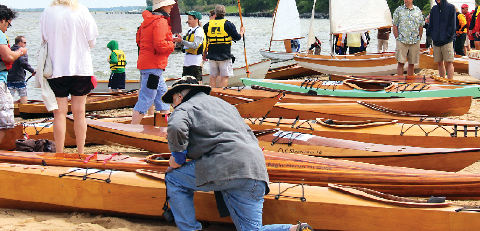 Photo courtesy of Chesapeake Light Craft
Photo courtesy of Chesapeake Light Craft
Backyard Boatbuilders Unite
Well, the first question you might be asking is, "What the heck is okoume?" And it's a good question, actually. Okoume is a tropical hardwood tree that's native to equatorial West Africa and ideal for manufacturing marine plywood. That marine plywood is a crucial component in the more than 26,000 build-it-yourself watercraft kits that Annapolis-based Chesapeake Light Craft (CLC) has shipped over the years. Add in an open house and a rendezvous on a warm, sandy Chesapeake Bay beach where you can try out one of these nifty boats firsthand and you've got OkoumeFest.
The annual celebration starts Friday, May 15, with an open house at CLC's world headquarters in Annapolis, where dozens of fully assembled CLC craft will be on display, ranging from eight-foot Cocktail Class powerboats to the 14-plus foot PocketShip, a cruising sailboat with micro dimensions. And of course, there will be all sorts and sizes of kayaks and nifty rowing craft to peruse.
Interested in getting an inside peek at the company's computerized kit-making operation? CLC staff will be on site to provide shop tours of the various manufacturing areas, as well as to answer your pressing questions about do-it-yourself boatbuilding, the company's kits, kit-building classes, or anything else that's on your mind. There are also boatbuilding seminars scheduled throughout the day that are packed with helpful tips for beginners and experts alike. It's an incredible opportunity to see if a build-it-yourself kit boat might be right for you. The fun starts at around noon, and wraps up with a burgers and brew seminar from 5 to 7 p.m.
The whole operation packs up and moves to Matapeake State Park on the Eastern Shore's Kent Island the next day, May 16, from 9 a.m. to 5 p.m. Here on the park's sandy beach you'll find a huge collection of CLC craft-from kayaks to prams to skiffs and sailboats. As many as 55 of the craft are from CLC's private collection-and available for folks to paddle and sail-while numerous others are proudly shown off by the folks who built them (many of these boats are true works of art). Awards are handed out for the best-looking builds, but the name of the game is reveling in the rarified atmosphere of beautiful small boats built by the ordinary folks who love them. The event is free and open to the public. For more information, visit
clcboats.com/boatbuilding-news-events.
April 9, 2015
Dabble in Deals at Dealer Days
You may already know Deltaville as a lovely boating destination. But what you may not know is that it's also a beehive of boat dealer activity, with four major new-boat dealerships representing 15 different boat manufacturers. If you're on the hunt for a new or previously loved boat, put this lovely little boating town on your calendar the weekend of May 2-3, when boat dealers in Deltaville, Va., host a two-day event with more than a dozen different boat brands represented.
The four participating dealerships-Annapolis Yacht Sales South, Chesapeake Yacht Sales, S&J Yachts and Norton Yachts-will open their doors for the weekend not just to give prospective customers a chance to look at shiny new and brokerage boats, but also to allow them to get to know the services and facilities they offer.
CBM can also confirm that there is plenty of good food, too, but no, we're not telling you which dealership usually has a slow cooker full of tasty pulled-pork barbecue; you'll have to find that out on your own. Heck, there's even a chance to win cash prizes. The fun runs 10 a.m. to 4 p.m. each day. Go to
deltavilleva.com/2015/02/16/dealer-days-2015 for the low-down.
April 9, 2015
Judge Throws the Book at Last "Stripergate" Poacher
Michael D. Hayden, 43, of Tilghman Island, the last of four defendants who were charged and plead guilty to various charges relating to the illegal harvest of 185,925 pounds of striped bass from the Chesapeake Bay between 2007 and 2011, was recently sentenced, and the judge showed very little mercy. U.S. District Court Judge Richard D. Bennett sentenced Hayden to 18 months in federal prison followed by six months of home detention for his leading role in the poaching operation. He was also ordered to pay $500,000 in restitution and received a $40,000 fine.
Hayden was considered the leader of a poaching conspiracy that began to unravel when Maryland Natural Resource Police officers found tons of dead striped bass tangled up in illegally set gill nets off Kent Island in February 2011. Hayden received a much harsher punishment than his codefendants primarily because he obstructed justice by threatening a witness.
"Mr. Hayden is being held justly accountable for his role at the head of a conspiracy to plunder protected striped bass from the Chesapeake Bay," says Assistant Attorney General Cruden. "The Justice Department, working closely with our state partners, will continue to protect these shared resources for the law abiding watermen of the Bay with vigorous prosecution of those who do not follow the law." Bad boys beware: the state isn't playing around, anymore.
April 9, 2015
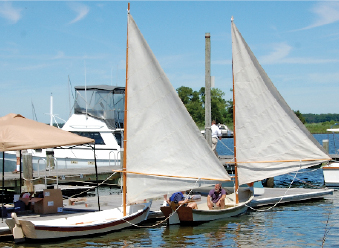 Photo courtesy of CBMM
Photo courtesy of CBMM
Rent a Classic
How does the idea of gliding down a picturesque Eastern Shore river in a beautifully crafted wooden sailboat or rowing shell this summer sound to you? (Pretty good, if you ask us.) And if it stirs your inner watercraft nerd as well, you'll be glad to know that the Chesapeake Bay Maritime Museum (CBMM) in St. Michaels, Md., is kicking off a brand-new boat rental program that's quite extraordinary.
Instead of curating a fleet of tired old rowboats or aging sailboats, CBMM is populating its rental fleet with a plethora of wooden watercraft that were built as part of the museum's "Apprentice for a Day" program over the last few years. Folks will be able to sail or paddle everything from kayaks and rowboats to all sorts of other traditional watercraft. Starting June 10, you can rent a boat for as little as an hour, or as much as a full day, every Wednesday through Sunday, until August 30.
Hourly rates will be $30 for sailing vessels; $160 per day. Rowing vessels will cost $20/hour; $100/day (museum members get steep discounts). Life jackets are provided. Don't know how to sail? No problem. The museum will provide, for a fee, lessons for those who need a primer on the basics of wind-powered boating. Visit
cbmm.org for more details.
April 9, 2015
Photo courtesy of Rappahannock River Oysters
Oysters Galore!
There's reason to celebrate in Virginia, when it comes to the Bay's briny bivalve, the Eastern oyster. Why? Because the Virginia Farm Bureau recently reported that the 2013-2014 Virginia oyster harvest topped 500,000 bushels, making it the biggest haul since 1987, and a 25-percent increase over the 2012-2013 season. The really good news is that experts suggest half of the harvest is coming from oyster farming (aquaculture).
While specific wild-versus-farmed figures haven't been presented, A.J. Erskine, aquaculture manager at Cowart Seafood in Lottsburg, Va., says his business is made up of about a 50-50 mix. "The wild harvest is extremely important," Erskine says, "however the complementary program is aquaculture, and the development of hatcheries out in the Bay and its tributaries provides a multi-pronged approach to recovery for a healthier oyster industry." Today the state has around 200 licensed oyster farmers.
The downsides to oyster farming are virtually nonexistent, and the practice provides lots of positive benefits for the Bay. With some operations having as many as two to three million oysters maturing at any given time, that means 100 to 150 million gallons of Bay water can potentially be filtered
daily by such an operation. Also important is that the practice does not involve dredging the important reef habitat provided by oyster bars to other key Bay aquatic species.
That said, some Maryland watermen have voiced concern about the rate at which the state of Maryland is leasing bottom in Chesapeake Bay. They claim that the cages and cultured bottoms used in oyster farming prevent them from running trotlines and pots for blue crabs in many areas.
Farmed oysters are widely available at seafood markets, restaurants and raw bars everywhere in Bay Country-just ask for them.
April 9, 2015
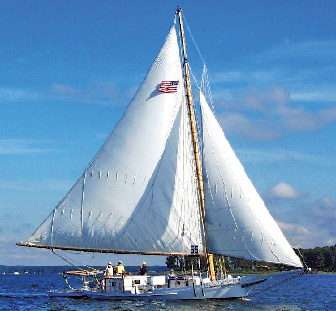 Photo courtesy of Reedville Fishermen's Museum
Photo courtesy of Reedville Fishermen's Museum
Start the Somers!
Sidelined due to a lack of funds and adequate crew to manage the century-old skipjack,
Claud W. Somers was relegated to being a shoreside exhibit at the Reedville Fishermen's Museum, where she has welcomed visitors aboard for two stationary years. Enter museum member Gerhard Straub, who volunteered to get the boat up and running again with a little help from museum volunteers who just needed someone to spearhead the effort. Join them on Sunday, May 24 from 3-5 p.m. for a gala food- and spirit-tasting party to support efforts to get her under way. Reserve your table today by calling 804-453-6529 or go to
rfmuseum.org for more information.
April 9, 2015
PredictWind (ChesapeakeDotCom)
No matter what sort of vessel we use, sail, power or manual, the wind determines what we can do on the water. Wind makes waves and heralds the weather changes we all watch so carefully.
There is an online site that is exceptionally useful, a sort of crystal ball of the air. It's called PredictWind (
www.predictwind.com) and it does just what its name says with considerable accuracy and precision.
The free version has enough features to be useful for skippers on the Bay all by itself. I have found the wind forecasts remarkably accurate, and the site gives animated predictions with arrows to show speed and direction for a week ahead.
Subscribe to one of the upgraded services and you get full weather routing that lets you plan everything from the best departure day to customized routes that avoid bad weather. Subscriptions range from $19 to $499 per year, with three-month plans also available. With a subscription plan, you also get progressively higher resolution forecasts and an array of maps showing swell, rain, clouds, isobars and sea temperatures as well as GPS services that will report your location to friends ashore.
There are apps for iOS and Android, so you can retrieve all this data wherever there is a cell phone signal, which should cover the Chesapeake fairly well. PredictWind also integrates with the Iridium GO! System for use offshore anywhere in the world for a reasonable price.
If you haven't explored weather routing services for a few years, prepare to be amazed.
-Tom Dove
March 19, 2015
New Outboard Engine Course
Due to high demand, the Annapolis School of Seamanship has introduced a new outboard engine mechanics course. The two-day session will cover operation, maintenance and basic troubleshooting of two- and four-stroke outboard engines. Register now for the first course, scheduled for May 16 to 17, by calling 410-263-8848 or online at
www.annapolisschoolofseamanship.com.
March 19, 2015
Kent Narrows Opened for Oyster Dredging Operations
After having been closed to oyster harvesting for six years due to health reasons, Maryland has allowed shellfish harvesting through the rest of the 2015 season. Read all about dredging on the Narrows
here.
March 19, 2015
Oyster Season Extension in the Works
After an icy winter on the Bay, during which oyster harvesting operations were severely hindered, Maryland DNR has requested a two-week extension of the season from the state general assembly's Administrative, Executive and Legislative Review Committee (AELR). The AELR has until March 27 to approve or deny the application. As of now, oyster season closes March 31. Read the full story
here.
March 19, 2015
Attention Rockfish Anglers:
The Maryland Department of Natural Resources yesterday announced that the regulations for this year's trophy fishery will include a one fish/person/day catch limit. The fish must be between 28 and 36 inches, or greater than 40 inches. This has been approved by the Atlantic States Marine Fisheries Commission's Striped Bass technical committee in accordance with Maryland's management proposal. The 2015 spring trophy fishery season will run from Saturday, April 18 to May 15.
March 19, 2015
Fire Extinguisher Recall
BoatUS has announced a recall concerning Kidde Mariner 10, Mariner 110, Mariner 5, and Mariner 5 G model fire extinguishers. About 4.6 million extinguishers are affected that were sold nationwide between August 2013 and November 2014. While it's always worth thoroughly inspecting all of the fire extinguishers aboard your boat at the beginning of each boating season, it will be particularly important this year.
Click here for all the details from BoatUS.
March 19, 2015
Pride Captain Takes Another Helm--Jamie Trost heads to Lake Erie to direct the Schooner
Porcupine project
Captain Jamie Trost, is heading to his hometown of Erie, Pa., to become Project Manager for the Schooner
Porcupine, currently being built at the Bayfront Maritime Center. The next time he sees the
Pride of Baltimore, he says, will be from the vantage point of another historically rigged ship. Trost skippered the
Pride for the last seven years, sharing the post with Captain Jan Miles. His new command is a replica of one of the schooner-rigged gunboats active in the Battle of Lake Erie (War of 1812). She will become a floating classroom for area school students.
March 13, 2015
Notice to Mariners
Northern Bay Ice Situation Update
Here's a great update from contributing writer Tom Hale about the ice situation on the northern Bay and Coast Guard's safety zone announcement:
As of noon, Friday March 13, 2015 there are US Coast Guard restrictions for vessels transiting the main stem of the Chesapeake Bay and its tributaries above the Bay Bridge except that the Patapsco River is open to navigation for all vessels. Steel hulled vessels are exempted from the restrictions; all other vessels may not get under way without the permission of the Commander of the Port of Baltimore.
The intent of the restriction was to limit the movement of aluminum hulled commercial vessels during the time the ice was particularly severe in Mid February. The Coast Guard did not expect there to be much recreational vessel traffic at that time of year, and so the recreational vessel segment was not considered at the time the restrictions were placed (The restrictions went into effect on February 17). The COPT is aware that there are recreational boaters who wish to be able to go out on the Bay north of the Bay Bridge this weekend.
At this time all recreational vessels must contact COPT at 410-576-2693 for permission to get under way. The COPT is looking at the impact on recreational boaters and expects to have an update sometime this weekend.
The Coast Guard's ice-related vessel and/or waterway restrictions are announced via Coast Guard broadcast notices to mariners, five times daily at 0300, 0705, 1130, 1600 and 2030 local time, on marine band radio VHF-FM channel 22A, and can be obtained via Sector Baltimore phone recording at telephone number 410-576-2682, or online at
www.uscg.mil/D5/ICE_REPORT/.
(Note: As of noon Friday March 13 the telephone system recorded ice report was 3 days old and is not consistent with the online data.
March 13, 2015
Notice to Mariners
Northern Bay Ice Situation
Attention Northern Bay boaters, the Coast Guard has announced a temporary safety zone "in ALL navigable waters within the northern portion of the Chesapeake Bay and its tributaries, including the western portion of the Chesapeake and Delaware Canal, between the Delaware/Maryland Boundary Line across the C&D Canal east of Chesapeake City, Md., and a line drawn across the Chesapeake Bay at the William P. Lane, Jr. (US-50/301) Memorial Bridges, located between Sandy Point and Kent Island."
The safety zone is currently in effect until April 15 (though the CG has said it will modify if necessary). So if you're planning on transiting north of the Bay Bridge best contact the authorities--Sector Baltimore Waterways Management Division, U.S. Coast Guard; telephone: 410-576-2674, email:
[email protected].
You can read the full notice here:
www.gpo.gov/fdsys/pkg/FR-2015-03-09/html/2015-05475.htm
March 13, 2015
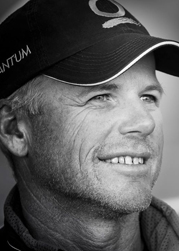
Kudos to Annapolis native Terry Hutchinson
Kudos to Annapolis native Terry Hutchinson who has just been named U.S. Sailing Rolex Yachtsman of the Year. The award is given annually to honor an individual's outstanding achievements in the world of sailing. Hutchinson, who is 46 and serves as Vice President of Quantum Design, premiere sailmakers also located in Annapolis, also won the Rolex award in 2008. According to news reports, he flew straight from the finish line at the Caribbean 600, where his boat,
Bella Mente, took overall and class victories, in order to accept this year's award at the New York Yacht Club.
"In some ways, it's not how you get knocked down, but how you get back up that's going to be the measure," he said, after thanking those who helped him along in his sailing career. "It's a testament to the owners and their faith and trust in the process that we apply to win races. What they have placed in my hands and what they have provided me as an opportunity to do on their behalf is not taken lightly."
According to the Quantum website, Hutchinson started sailing in a Dyer Dhow when he was three years old. A 1986 graduate of St. Mary's High School, he was a four-time All American sailor at Old Dominion University where he was named collegiate Sailor of the Year in 1989 and 1990. A 2008 MedCup Champion with Quantum Racing, he won his first Rolex award that same year. In 2014, Hutchinson compiled an even more impressive list of victories on his way to earning his second award.
March 12, 2015
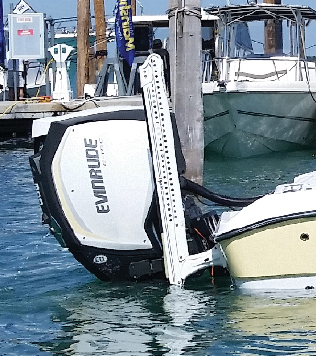 Photo courtesy of BRP-Ecinrude
Photo courtesy of BRP-Ecinrude
Biobutanol Delivers
Some lucky visitors to February's Miami International Boat Show got the chance to ride on a Crevalle 25 Bay Boat pushed by a brand-new 300hp Evinrude E-Tec G2 outboard motor and carrying a decal with the legend fueled by biobutanol. Instead of ethanol, the boat was running a blend of 83.9 percent standard gasoline and 16.1 percent biobutanol, a second-generation biofuel derived from the same basic plant "feedstocks" as ethanol but much friendlier to marine engines. This conclusion comes from four years of research by a partnership of engineers from Bombardier Recreational Products (the parent company of Evinrude), the U.S. Department of Energy's Argonne National Laboratory, Volvo Penta, Indmar, the National Marine Manufacturers' Association (NMMA) and the American Boat & Yacht Council (ABYC).
Even though the concentration of biofuel powering the big Evinrude was well past what is considered a safe level for ethanol, the engine ran like a top during the show. Jeff Wasil knew it would. Engineering Manager in Emissions Testing, Certification and Regulatory Development for BRP-Evinrude, Wasil has been at the center of the experiments with biobutanol for the past four years, spreading the word about the partnership's research in gaseous and particulate engine exhaust emissions, combustion analysis, cold start, runability and durability. In that time, the team has tested many engine technologies from engine and boat manufacturers including four-stroke carbureted and fuel-injected outboard engines, conventional two-stroke carbureted outboard engines, stern drive engines and E-TEC direct fuel injection outboard engines.
Biobutanol's value in marine engines includes a higher energy density than ethanol, much less tendency to attract and mix with water, less corrosiveness and much better stability. "Boaters had the opportunity to test how the fuel works firsthand here at the [Miami] show, and that's definitely part of the equation in creating interest and demand for this next-generation biofuel," said Wasil. "We've been collaborating across the industry for several years and have published multiple papers on our findings. The data, paired with the experience, will definitely help us move the fuel conversation forward."
Although the availability of biobutanol fuels at marinas and boat fueling stations is expected to take time, sharing marine industry research on biobutanol fuels is essential to creating a market and the adoption of this fuel. What's next? Pushing up the proportion of biobutanol to see how much marine engines can take without damage, both in the lab and on the water. And working with the two current producers of biobutanol, GEVO (
www.gevo.com) and Butamax (
www.butamax.com, a BP/DuPont joint venture) on future production plans. Changing the fuels we use nationwide is like turning a very large ship. It takes patience. But BRP, the Argonne Lab, NMMA, ABYC, Volvo Penta, Indmar and their partners are on a promising road. We'll look into the biobutanol story some more this summer.
-John Page Williams
March 12, 2015
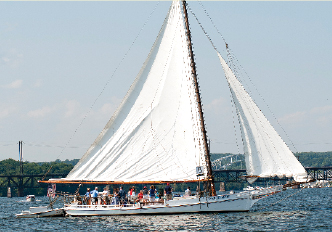 Photo by Michael C. Wootton
Photo by Michael C. Wootton
Historic Skipjack Martha Lewis in Trouble
Twenty years may not seem like a long time in the grand scheme of things, but when you're talking about wooden boats, two decades of exposure can have a profound effect on their bones. Such is the case with the skipjack
Martha Lewis. Even after a complete refit in 1994, today the graceful old girl is in need of some serious repairs-at least $21,000 worth.
The skipjack's old planks failed to swell enough to sufficiently float her after a routine dry dock visit in Baltimore, which means major bottom work is in order. Plus, a new mast has to be installed, and she may require a new boom and a rigging refit. Unfortunately, the group who cares for the skipjack doesn't have 21 grand lying around.
The Chesapeake Heritage Conservancy (CHC), a non-profit group that maintains the
Martha Lewis as an environmental education platform, is asking for donations to help fund the repairs. Donated to CHC in 1994 by Dr. Randy George of Birmingham, Ala., the skipjack was fully restored that same year through a partnership with the city of Havre de Grace and the Havre de Grace Maritime Museum. When she's not under the weather, the
Martha Lewis sails the out of Havre de Grace, Md., educating folks on the intricate Chesapeake ecosystem.
One of a handful of skipjacks remaining from a fleet that originally numbered near the 2,000 mark,
Martha Lewis was built by Bronza Parks and launched from Wingate, Md., in 1955. Parks also built the skipjack
Rosie Parks, which was recently restored by the Chesapeake Bay Maritime Museum in St. Michaels, and the
Lady Katie, now sailed by Captain Scott Todd out of Cambridge, Md.
You can help preserve this bit of Chesapeake history by making a donation to the organization. Visit
chesapeake-heritage.org and click on "Donate."
March 12, 2015
Snaggletooth Shark Caught in Fisherman's Backyard
Chesapeake Beach charter boat captain, Shawn Gibson, made the catch of his life last October . . . in his parents' backyard, a quarter-mile from the Bay. The fisherman and his family unearthed the fossilized remains of a 15-million-year-old snaggletooth shark (yes, that's really what it's called) while digging footers for a deck.
The Gibson family home happens to be located on one of the richest deposits of Miocene fossils in the U.S., if not the world, and like many residents of the Calvert Cliffs area, they have always been on the lookout for fossilized sharks' teeth and other marine fossils.
"We were never serious fossil hunters, but we are aware that there are plenty of things to find in the clay and sand," Shawn Gibson said. When his brother Donald was digging footers for the porch, he noticed what appeared to be a vertebra in the dirt pile. "It had rained on the dirt and kind of washed it off," said Shawn. Donald, Shawn and their kids started going through the pile to see what else they might find, uncovering about two dozen vertebrae.
The thing about living in the middle of an epic fossil deposit is that there are plenty of people who get educated on the subject, meaning there is usually someone to call if you find something interesting. Shawn called his mate on
Wound Tight, the 46-foot Markley he keeps at Herrington Harbour South. Scott Verdin is an amateur fossil hunter, and he immediately recognized the significance of finding so many vertebrae together. Another friend, Pat Gotsis who volunteers at the Calvert Marine Museum's fossil collection, also came to check out the find.
They dug every day after work, finding three vertebrae in a row, and then a tooth that was an inch and a half. Gotsis immediately identified the tooth as coming from a
Hemipristis serra, an extinct snaggletooth shark.
Shawn called the Calvert Marine Museum in nearby Solomons, Md., and spoke with Curator Dr. Stephen Godfrey. "You could tell at first he was a bit skeptical, but interested. By that time, I had learned enough to explain pretty clearly that we had what appeared to be the intact skeleton of a
Hemipristis serra with vertebrae leading up to a skull and teeth."
Dr. Godfrey's assistant, John Nance, said that he could tell that his boss was "visibly excited," after the call. Nance, 27, a lifelong fossil hunter from Calvert County had begun volunteering with Godfrey while he was still in high school. Now the two work closely together in the museum's jam-packed paleontology lab. Nance shared Godfrey's excitement, "This is not the kind of call you get every day."
The two arrived at the Gibson house a week after the first vertebra was discovered. Nance says he will never forget the feeling of seeing the semi-unearthed skeleton. "It was jaw-dropping," he says. "I knew immediately I was seeing something that most paleontologists only dream of." The shark appeared to be buried completely intact-a whole skeleton in one place. This is highly unusual, according to Nance, since in a marine environment dead animals would tend to be picked at by scavengers or broken up by the water.
A CT scan of the fossilized remains showed something else that is amazing about the shark: a lot of cartilage in the soil along with teeth and bones. "This tells us that it died and was buried very quickly," said Nance. "Something catastrophic happened."
Nance is currently working to extricate the skeleton from its sandy bed. The Gibson family has agreed to loan the fossil to the museum, where it will ultimately be displayed-after Nance removes the rest of the soil, one milligram at a time.
-Kathy Bergren Smith
March 12, 2015
Courtesy of Annapolis Boat Shows
Bay Bridge and Annapolis Spring Boat Shows Roll into Chesapeake Country
The floating docks at Pier One Marina on Kent Island will fill with shiny new watercraft and white tents will rise into the sky as the Bay Bridge Boat Show gets under way April 17 through 19, at the eastern end of the Chesapeake Bay Bridge. Only a few days later, masts will sprout like trees in downtown Annapolis as sailboats roll into Ego Alley for the Annapolis Spring Sailboat Show, which runs April 24 to 26. Ah, yes, we can't wait to get a whiff of some of that new-boat smell.
Having a powerboat and fishing slant, the Bay Bridge Boat Show this year will feature 100 new and brokerage boats to board and peruse. The Demo Dock returns, giving prospective buyers a chance to kick the tires and take boats out for a sea trial. You can also take a kayak out for a paddle.
On land you'll find more boats and hundreds of marine vendors-from marinas to marine engine manufacturers-available to answer your questions or sell you the latest in marine gear. There are opportunities to learn something new, with fishing rod building demonstrations by local tackle guru Joe Cap, a how-to on preparing a proper Eastern Shore feast by a local chef, and free seminars on a variety of topics from area boating and fishing pros. Need to bleed some energy off your little ones? Take them to the moon bounce or have an artist dress them up with face paint. If you attend the show on Friday, stick around for the Opening Night BBQ Bash (free for attendees) from 5 to 8 p.m.
But maybe powering away under sail in a stiff breeze is more your thing. In that case, head to the Annapolis Spring Sailboat Show, which takes place the following weekend. That's where you'll find nearly 80 sailboats on display in Ego Alley, along with more than 100 land exhibits featuring the latest in all sorts of sailing gear and services. If you're new to sailing and want to give it a try, Annapolis Community Boating will provide free rides on a variety of sailboats from the show docks. Yes, free.
Starting a day before the show and running until the last day is Cruisers University, a program that teaches attendees everything from diesel mechanics to navigation and air-conditioning to anchoring. Tuition packages range from $190 to $590, depending on the number of days and types of classes you choose. It's a great way to learn from the pros. Lastly, if you find yourself at the show on Friday afternoon, make a beeline to the Opening Day Celebration, which will feature live entertainment, a cash bar and complimentary hors d'oeuvres from 5 to 8 p.m.
The Bay Bridge Boat Show runs from April 17 to 19. Parking is available on site with a $3 donation to the Kent Island High School Athletic Boosters.
The Annapolis Spring Sailboat Show is open April 24 through April 26.
Both shows are open from 10 a.m. to 6 p.m. each day, except for Sunday, when the shows wrap up at 5 p.m. Adult tickets are $12 each; $19 for a two-day combo pass. Children ages 12 and under are admitted free.
For more information, visit
annapolisboatshows.com
March 12, 2015
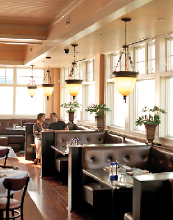 Courtesy of Oyster Farm Seafood Eatery
Courtesy of Oyster Farm Seafood Eatery
New Marina! More Oysters!!!
The Oyster Farm Seafood Eatery opens in April, part of the new Oyster Farm at Kings Creek (formerly Bay Creek Marina).
Robert Occhifinto, who purchased the defunct marina property in 2013, is creating a large-scale oyster farming operation on site and plans to make his home-grown oysters the restaurant's main focus (along with other savory seafood dishes under the guidance of chef Shelly Cusmina). Oyster cages measuring 20 inches in diameter and six feet long, each with 10 compartments, will line the sides of the marina docks, producing oysters Occhifinto has dubbed "Kings Creek Salties."
Marketing consultant Hope Lawler said the idea is to have an interactive, festival-like environment on the docks, with hands-on demonstrations of oyster growing, oyster shucking and the process of getting the tasty bivalves from the water to the palate. "We want it to be very family-friendly," Lawler adds. Patrons of all ages will be able to interact with the oyster-farming process.
The same atmosphere will be true for the restaurant, which Lawler describes as "casual plus." The space will include a 20-foot-long fish tank filled with stingrays, as well as a tank with fresh lobsters and crabs. The oyster bar, besides serving oysters on the half-shell, will offer up a zesty line of oyster-based cocktails.
The marina will continue to offer transient slips to boaters moving around the Bay (MLW 6 ½ to 7 ft, electric, WiFi, laundry, showers . . . ).
www.theoysterfarmatkingscreek.com; for slip reservations call 757-331-8640.
-Bill Sterling
March 12, 2015
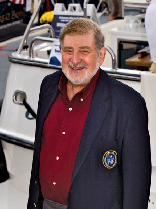
In Memoriam:
RICHARD SCHWARTZ
BoatU.S. Founder Passes Away
Richard Schwartz, chairman and founder of the Boat Owners Association of the United States (BoatU.S.), passed away February 11 after a brief illness. He was 85 years old.
Schwartz grew up in Mount Vernon, N.Y., the son of a service station owner. He attended Princeton University, and then studied law at Yale before going on to practice anti-trust law in the Washington, D.C., area.
Schwartz founded BoatU.S. in 1966 after an eye-opening boat ride on Chesapeake Bay aboard a friend's boat, according to a profile on the BoatU.S. website. The U.S. Coast Guard boarded them, and after a safety inspection Schwartz's friend was cited for having an inadequate engine room ventilation system. What shocked Schwartz was that the manufacturer of his friend's boat couldn't be held liable for not following U.S. Coast Guard regulations. Likewise, the U.S. Coast Guard couldn't force the manufacturer to abide by those same rules.
After learning that there were no groups that served as a voice for boaters, Schwartz founded BoatU.S. Schwartz's subsequent testimony and work on Capitol Hill helped lead to the passage of the Federal Boat Safety Act of 1971. The legislation gave the U.S. Coast Guard the authority to hold boat manufacturers accountable for certain boating safety standards and created the U.S. Coast Guard Office of Boating Safety.
BoatU.S.'s further advocacy under Schwartz's leadership would result in the passage of the Recreational Boating Safety and Facilities Improvement Act of 1979, which dictated that taxes and fees paid by boaters should support boating programs; the adoption of the Wallop/Breaux Trust Fund Amendment in 1984 that today returns more than $600 million annually to boating and fishing programs; and the repeal of the luxury tax on boats in 1992 and the diesel fuel tax in 1997.
BoatU.S. grew far beyond Schwartz's advocacy over the years, providing boat and towing insurance for boaters; operating discount retail locations around the country; developing the BoatU.S. Foundation for Boating Safety and Clean Water; and producing the largest boating publication in the country, BoatU.S. Magazine. Today the organization boasts more than 500,000 members and insures thousands of boats worth a combined hull value of more than $8 billion.
Schwartz retired from BoatU.S. in 2013 after 47 years of work saying, "We've become the largest boat owners organization in the United States and fought major boating battles along the way, making life better and safer for boaters, all the while creating the services that make the boating experience better. Boating should be a pleasure-not a hassle. I am proud to have led this organization."
March 12, 2015
It's Tax Time: Look to Your Boat for Deductions
If this magazine is sitting on your dining room table next to a pile of 1099s, W-2s, 1040s and other miscellaneous tax forms, it's likely you haven't done your taxes yet. Lucky for you, we're here with some sweet relief-that is if you're a boat owner whose boat and personal income meet some specific requirements.
First of all, the federal tax deduction for state sales taxes, including those paid on boats, was extended for the 2014 tax year under the Tax Increase and Prevention Act of 2014. According to BoatU.S., "Boaters must choose either the state sales tax deduction or state income tax deduction on their federal tax return-you cannot take both. In addition, to take the state sales tax deduction, the sales tax on a boat purchase must be applied at the same tax rate as the state's general sales tax. State sales taxes are entered on IRS form Schedule A, line 5b. For state tax deduction information, download Publication 600, which also includes state-by-state tax tables."
Next up, boaters who have a secured boat loan may deduct the mortgage interest paid from their federal income taxes. Again, BoatU.S. has the rundown: "Taxpayers may use the home mortgage interest deduction for (a single) second home in addition to their primary home, and must itemize deductions on their returns. A boat is considered a second home for federal tax purposes if it has a galley, an installed head and a sleeping berth. For more details on the mortgage deduction on boats that qualify, go to irs.gov and download Publication 936 or the Fact Sheets."
OK, that's the good news. The bad news is folks who fall under the pesky Alternative Minimum Tax rule are generally ineligible for these deductions. Shucks. For more information, download the forms above, or consult your tax preparer.
March 12, 2015
Kinder, Gentler Registration
In December, Washington, D.C., joined Virginia and Connecticut in adopting the Uniform Certificate of Title for Vessels Act (UCOTVA), a law aimed at making vessel registration simpler and more uniform throughout the United States. The Act is designed to unify procedures and titling laws between different states and brings state boat registration laws in line with the modern Uniform Commercial Code, which governs security interests and the sale of goods in all 50 states.
In addition, vessels titled in states adopting the Act should eventually be eligible for what are called "preferred ship" mortgages that would take precedence over any additional liens. (Under current federal law, preferred ship mortgages are only available for U.S. documented vessels, not state-titled boats.) Both Virginia and D.C. passed the Act with a provision that "brands" titles of vessels that have been significantly damaged by a casualty or sinking. Now boat buyers in Virginia and D.C. will be forewarned if a vessel has had significant damage, and brokers selling boats with a clean history can clearly demonstrate that the vessel they're selling is shipshape.
-Greg Singer
March 12, 2015
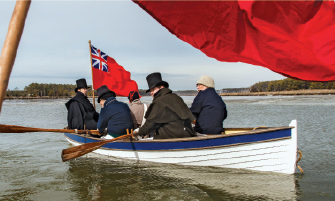 Photo by Robert Stefan Bartgis
Photo by Robert Stefan Bartgis
The Last Battle, Again
Shots rang out over the waters of the Little Choptank River early in February when over 40 reenactors gathered to commemorate the skirmish known as the Battle of the Ice Mound, the final conflict in the Chesapeake during the War of 1812.
In the weeks before the ratification of the Treat of Ghent the British schooner
HM Dauntless sent raiding parties into the communities and farms of Maryland's Eastern Shore. On February 7th her tender became trapped in the ice near Taylors Island, where she was discovered by a patrol from a local detachment of the 48th Maryland Militia. They made their way onto the frozen river, found a mound of ice to use for cover, and opened fire with their muskets.
The British returned fire for nearly two hours before they surrendered. Sixteen American privates captured two officers, three Royal Marines, thirteen sailors and two African Americans-plus their weapons: seventeen muskets and a carronade.
Two hundred years later the commemorative "battle" drew over 500 spectators who watched as reenactors portraying the British struggled against very real ice in three reproduction wooden boats under a steady stream of American militia "fire."
Mark Dubin, a member of the militia unit the Chesapeake Independent Blues and part of the event's planning committee, was excited that so many people came out for the only 1:1 reenactment of a battle to take place during the War of 1812 Bicentennial. His militia's adversaries were portrayed by Ship's Company Living History (
shipscompany.org), which offers unique volunteer opportunities with historic sites and wooden boats in the Chesapeake for those who want to experience history first hand.
-R. Ben Bartgis
March 12, 2015
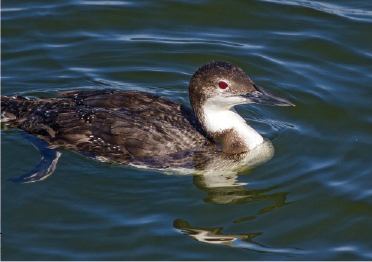 Photo by Amber Hart
Photo by Amber Hart
Loons Spread the Good News about Menhaden
Autumn brings all manner of migratory waterfowl to the Bay, loons among them. They are the size of a goose, and are partial to the Bay's annual crop of "peanut" menhaden nurtured on plankton in countless creeks over the warm summer.
By fall, these fish are about five inches long, and already they form dense schools. The newly arrived loons practice an "intercept fishery" on the peanuts, forming noisy cooperative flocks in the lower reaches of some Bay tributaries. They act like a live fishing net, most of them underwater at any given time, surfacing only to gulp air for a second then dive again.
The water is dense with plankton, and the diving loons often push their prey toward the surface for easier visibility. Gulls know all about this, and several species hover to take fish at the surface, benefitting from the loons' expertise.
After awhile the loons surface to breathe and digest. That's when an observer realizes that what looked like a dozen loons is actually a flock ranging from 30 to 80 birds.
What you're seeing here are cooperative predation tactics by highly intelligent, long-lived water masters who know how to make the most of their annual Chesapeake stopover. But, for this to work, the peanut menhaden prey base must be abundant, and that has been deficient for some twenty years.
Since the early 1990s, menhaden have been overfished. One indicator of that was the reduction in the Bay's annual loon count. The big musical autumn loon flocks I witnessed on the Bay in the 1980s gradually dwindled to a fraction of their former size.
When the Atlantic States Marine Fisheries Commission finally moved in 2012 to institute a biologically realistic cap on the menhaden harvest, I had hopes that my lifetime studies of bird monitors such as Chesapeake loons and Connecticut River ospreys would demonstrate menhaden recovery. I am pleased to report that 2014 observations of both species' abundance say a resounding yes!
For the first time in two decades, I tallied 400 loons on a calm afternoon last November, most of them in feeding flocks of 30 to 110 birds on the Choptank River and Eastern Bay.
This is excellent news for all of us who live along the East Coast. Ecologically speaking, menhaden spin straw into gold. As our civilization drenches our coastal waters with nutrients, plankton populations swell, ultimately depleting dissolved oxygen and creating biological hazards like dead zones and red tides.
Menhaden is a filter-feeder, meaning that it virtually sucks up plankton and passes it up the food chain. Which happens to be our food chain-menhaden are prime prey for rockfish and bluefish as well as loons and osprey (not to mention its local value as crab bait). It is the basis of many of the small businesses that benefit from the Bay, from restaurateurs to charter fishing fleets, and its regenerative qualities will have a far-reaching impact both economically and environmentally.
-Paul Spitzer, PhD
February 20, 2015
CBM Wins Big at Annual Boating Writers International Awards
Congratulations to Chesapeake Bay Magazine's winners in this year's Boating Writers International competition. The awards ceremony was held February 13 at the Miami Boat Show and Chesapeake Bay Magazine's writers nabbed six awards. Here is the list of winners; click on the highlighted story titles to read!
Marty LeGrand won First place in the Ethics & Environment category for her story "Thar She Blows," which covered the controversial process of sounding for oil in the Atlantic, which potentially harms marine life.
Wendy Mitman Clarke won Third place in the same category for her story "Long Way Home," which details the life cycle of the American eels that depend on the Bay.
Jody Argo Schroath earned a Second place spot in the Destinations category for her story "
Cherries Jubilee," about her cruise up the Potomac River to visit Washington, D.C. to see the cherry blossom trees in bloom.
Michael Fincham won First place in the Seamanship, Rescue & Safety category for his "Remembering the Cuyahoga" story, about the collision between U.S. Coast Guard cutter Cuyahoga and a 512-foot freighter, and the Cuyahoga's subsequent sinking and rescue of its crew.
Wendy Mitman Clarke also won a Certificate of Merit for her column, Weather Eye; and Tim Sayles also earned a Certificate of Merit for his destination story "
Three Days Before the Museum," a three-day adventure at the Chesapeake Bay Maritime Museum in St. Michaels.
Congratulations to all of our winners!
February 11, 2015
Notice to Mariners
MD Chesapeake Bay Bridge, Eastern Channel: Submerged object
The Coast Guard has received a report of a submerged object located near the Chesapeake Bay Bridge. The object is reported to be a sunken vessel, 32-35 feet in length, in an upright position on the bottom in approximately 89 feet of water. The object is located approximately 100 yards north of the north (westbound) span of the bridges, northwest of the Eastern Channel, in approximate position latitude 38°59'27.0528"N, longitude 076°21'37.1880"W (Lat. 38.990848 Lon. 76-360329). The object is reported to be drifting southward along the bottom, as indicated by the presence of drag marks. Interested mariners can contact U.S. Coast Guard Sector Baltimore at telephone 410-576-2674.
February 10, 2015
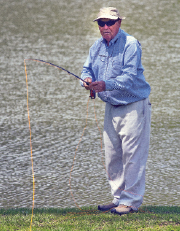 Photo by John Bildahl
Photo by John Bildahl
Tie One On at TieFest
If there's a superhero equivalent to Superman in the world of fly-fishing, it's Maryland's own inimitable Bernard "Lefty" Kreh. Now touching 90, yet still traveling the world honing his craft, Kreh is almost universally regarded as the founding father of saltwater fly-fishing-and the Jedi master of the sport in general. In fact, many refer to him as the "Yoda" of fly-fishing.
If you'd like to meet Kreh, have him sign one of his many books, or see him give one of his not-to-be-missed fly-casting demonstrations, be sure to tick off Saturday, March 7 on your calendar. That's when Kreh will attend his namesake fly-fishing event, Lefty Kreh TieFest, at the Prospect Bay Country Club (313 Prospect Bay Drive West, Grasonville, Md.) between 11 a.m. and 5 p.m. Coastal Conservation Association (CCA) members get in free, while $10 gain admission and a one-year CCA membership for all others.
Now in its 14th year, TieFest is organized by the Maryland chapter of CCA as a grassroots effort to further fisheries conservation and foster all types of angling on Chesapeake Bay. In addition to Kreh, the venue will be packed with other fly-fishing luminaries including Bob Clouser, Bob Popovics, Brad Buzzy, Steve Silverio and Blaine Chocklett, who will give face-to-face fly-tying demonstrations and be available to chat it up with attendees.
That intimacy is unique, explains Tony Friedrich, CCA Maryland's executive director. "This is a small venue. Unlike many of the large fishing shows, where it's almost impossible to speak with or ask questions of these legends, at TieFest, these guys are totally accessible to attendees," Friedrich says, adding, "It's all for a good cause. These guys aren't paid to be at the event, but feel strongly about furthering CCA's conservation causes and promoting the sport of angling."
For more information, visit
ccamd.org.
February 10, 2015
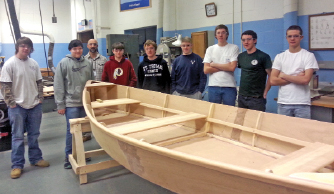 Photo courtesy of MTAM
Photo courtesy of MTAM
Heigh Ho, Heigh Ho!
I, your humble scribe, am a pretty good example of someone who didn't belong in, or want to attend college right out of high school. Which, of course, terrified my parents. No, I was filled with wanderlust, hoping to travel the globe in my small, 27-foot sailboat instead.
Luckily for me, I ended up first at a marine supply shop that recognized the potential to turn my passion for boating into a career. And that's a great aspect of the marine trades: Most anyone who works hard and has a certain knack for boats and boating can do very well in a marine trades career. While I eventually went to college later in life, that early job pointed me in a sustainable career direction that's lasted for 25 years.
The Marine Trades Association of Maryland (MTAM) is celebrating this theme in 2015 by working with Maryland-based marine businesses to kick off what it hopes will be an annual program of six-week paid internships. "The idea is to provide a stepping stone for anyone interested in a marine trades career," says Susan Zellers, who is heading up the program for MTAM. The internships are being funded by a grant from the Maryland Department of Labor Licensing and Regulation's Employment Advancement Right Now (EARN) program, which is designed to create career paths to quality jobs within the state.
Working with more than thirty industry organizations, including the magazine you are now reading, MTAM is hoping to place qualified candidates into a diverse field of positions, with a focus on jobs that involve repairing and servicing boats, marine engines and electronics as well as support jobs in IT and marine business management. "These are great positions for people looking for variety in their everyday work life," Zellers says. "No two days in a boatyard or marina are ever the same. One day you might be peeling away the layers to diagnose a complex onboard electrical problem while the next you might be repairing a structural issue with epoxy resin and carbon fiber."
Candidates accepted into the program will first attend a three-day orientation at Camp Letts (on the West River), May 1 to 3, where they will attend workshops covering topics ranging from basic boat handling to job readiness and customer service skills. Attendees also will visit a nearby boating facility for a tour. Accommodations and meals are included. "Upon successful completion of the immersion program, internship candidates will be placed with our industry partners around the state, with most of the internships beginning after the busy lead-up to the Memorial Day weekend," Zellers says. "The hope is that many of the candidates will further move on to permanent positions within the marine industry as a career," she adds.
For full details about the program or to fill out an application, visit the MTAM website at
mtam.org/jobs-career-training/training-for-the-marine-trades/application.
February 10, 2015
Photo courtesy of Deltaville Maritime Museum
Deltaville Maritime Museum's Oar House Grows
A new 24-by 48-foot expansion will form workspace where boat shop volunteers will restore and build classic Chesapeake workboats for display and use. More details at
deltavillemuseum.com
February 10, 2015
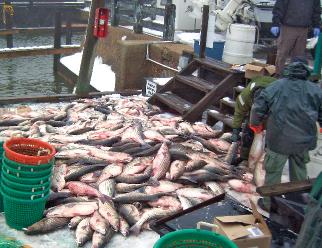 Photo courtesy of Costal Conservation Association Maryland
Photo courtesy of Costal Conservation Association Maryland
Poachers Face the Music
You may remember the pictures from February 2011, which show a sickening pile of thousands of pounds of dead striped bass tangled up in illegal gill nets that had been retrieved by the Maryland Natural Resources Police (NRP) just south of Kent Island, Md. Justice was finally served to three of the four individuals responsible not only for those fish, but also a broader poaching scheme.
Commercial fishermen William J. Lednum, age 41; Michael D. Hayden, age 43; Kent Conley Sadler, age 31 (all of Tilghman, Md.); and Lawrence "Daniel" Murphy, age 37, of St. Michaels, Md.; all pleaded guilty in 2014 for their parts in a scheme to poach approximately 185,925 pounds of striped bass from the Chesapeake Bay between 2007 and 2011. The federal charges were a result of a larger investigation that fired up after the discovery of the aforementioned illegal gill nets in February 2011.
According to a Maryland Department of Natural Resources (DNR) release, "From at least 2007 to 2011, Lednum and Hayden engaged in a scheme to illegally poach at least 185,925 pounds of striped bass from the Chesapeake Bay. In an effort to conceal their crimes, Lednum and Hayden admitted that they falsified paperwork related to their harvests and submitted those falsified documents to the state of Maryland. Lednum and Hayden shipped and sold the striped bass to wholesalers in New York, Pennsylvania, Delaware and Maryland, receiving a total of $498,293.47 for the poached fish."
Lednum was sentenced by U.S. District Court Judge Richard D. Bennett on December 17 to one year and one day of prison, followed by six months of home detention and three years of supervised release. He must also pay restitution in the amount of $498,923 plus a fine of $40,000. Lednum could have faced up to five years in federal prison, the maximum sentence for the offenses.
Murphy, who played a smaller role in the crimes as a "helper" aboard one of the vessels used for poaching the striped bass, was sentenced on December 19. He received probation and was ordered to pay a $10,000 fine and $30,000 in restitution, according to court documents. Murphy could have faced up to five years in prison. A
Baltimore Sun article explained that while a court-appointed attorney claimed Murphy earned only about $16,000 from the illegal poaching, Judge Bennett said he wanted to send a message to other watermen that poaching is a "very, very serious matter."
Sadler, also a "helper," was sentenced on January 7 to 30 days in jail, a $5,000 fine and restitution of $20,000.
Hayden's sentencing was scheduled for February 27, after this issue went to press. His sentencing was delayed so the judge could assess several additional counts that he allegedly obstructed justice by intimidating witnesses related to the poaching case.
"We are very pleased with today's court decision," says DNR Secretary Joe Gill. "These individuals were stealing from Maryland citizens and law-abiding watermen. We are proud of the great work done by NRP officers."
Chesapeake Bay Magazine was unable to reach Maryland Watermen's Association president Robert T. Brown, Sr., for comment on the sentencing at press time.
February 10, 2015
Cover image courtesy of Shawn Kimbro
Chesapeake Fish Whisperer Publishes Second Book
Angler extraordinaire Shawn Kimbro is at it again. He has just published his second book,
The Right Stuff, in which he talks about some of the intangibles that can make Chesapeake anglers successful.
The book's subtitle tells a lot:
Gear and Attitudes for Trophy Light Tackle Fishing. The "gear" part is an evolution of the material found in Kimbro's first book,
Chesapeake Light Tackle, which is based on his Chesapeake Bay fishing experiences. The fishing gear aspect of Kimbro's first book is solid, but it's there in a supporting role. In his new book, it's the lead character.
What is unique about
The Right Stuff is the way Kimbro brings his fishing attitudes and thought processes down to earth both clearly and passionately. Even better, Kimbro intersperses chapters such as "Haunted By Waters," "Strike Triggers," and "The Right Stuff: Creativity" with entries and on-the-water observations from his popular blog at
chesapeakelighttackle.com.
The book's two final chapters delve articulately into deeper waters: "The Right Stuff: Dedication" and "The Right Stuff: Giving Back." The book is a well-crafted blend of practical suggestions grounded in time on the water and philosophical concepts about which Kimbro has thought deeply. It's a great gift to the Chesapeake's angling community.
Kimbro's book is available for purchase at many Bay-area tackle shops and outfitters, as well as from his website,
chesapeakelighttackle.com.
-John Page Williams
February 10, 2015
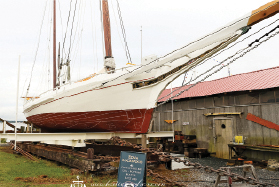
Calling All Pines
You'd be tired, too, if your bottom was 126 years old. That's how long it's been since the Chesapeake Bay bug eye
Edna E. Lockwood's pine-log bottom first touched the Chesapeake Bay at Tilghman Island in 1889. Today, her original bottom needs replacing.
A National Historic Landmark, the
Edna E. Lockwood was donated to the Chesapeake Bay Maritime Museum in 1973 after working a lifetime on the Bay dredging oysters and serving a brief stint as a pleasure vessel. In 1995, she was completely stripped down to her original nine logs and reconstructed from the bottom up.
Perhaps six lifetimes old in bugeye years, the bugeye's 126-year-old bottom now needs to be completely re-crafted from scratch. But finding the right Southern pine logs (locally known as loblolly pine) for the job is turning out to be quite a challenge. Even sawmills and lumber brokers are having a difficult time finding the dozen Southern yellow pine logs needed for the task. The logs must be three to four feet in diameter and at least 52 feet long.
You might think, "Why the heck don't they just use shorter pieces and plank them together?" Because that's not how log-bottomed bugeyes were built. Chief curator Pete Lesher explains: "Log construction was a hallmark of Chesapeake boatbuilders. They would flatten the sides of the logs and join seven, nine, or even eleven logs side-by-side and hew them to shape with axe and adze. Entire bottoms were fashioned from solid chunks of wood in this manner. The largest and longest log was used for the center, and the hulls were sharp at both ends-like an oversize canoe."
Once the proper logs are secured and funding acquired, the bugeye will be pulled up on the museum's marine railway so that the restoration can be done in full public view.
February 10, 2015
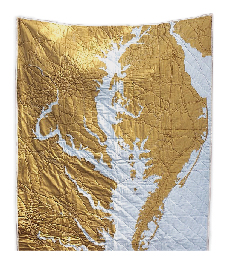 Photo courtesy of Haptic Labs
Photo courtesy of Haptic Labs
A Patchwork Bay
You might think a quilter would be the last career diversion an architect would take, but according to the
New York Times, that's exactly what Brooklyn, N.Y., resident Emily Fischer did when she was laid off from her architecture job in 2009. Today, the company she founded, Haptic Labs, produces quilts, kites and furniture that represent the natural and manmade world. Now she's turning her creative eyes toward the Chesapeake.
Her company is releasing a line of "Coastal Quilts" that will include a 54- by 72-inch representation of Chesapeake Bay. The Chesapeake Bay quilt joins several other quilts including representations taken from satellite images of Martha's Vineyard, Cape Cod and the Great Lakes. The handcrafted works are accurate down to their individual threads, which represent the major roads and interstates that crisscross each area.
The idea for the quilts started right here in Chesapeake Country, says Fischer. "A client of mine lives on Tangier Island and encouraged me to design a collection of coastal quilts; the entire series really started with a Chesapeake quilt I made back in 2012."
The Chesapeake Bay quilt retails for $289 and is expected to be available in March or April, with preorders being shipped first. For more information, visit Haptic Lab at
hapticlab.com.
February 10, 2015
Tohatsu Marine To Stop Producing Nissan Outboards
The Tohatsu brand and product line will live on, however. Company cites declining powerboat sales in Japan as primary factor for nixing Nissan-branded outboard motors.
February 10, 2015
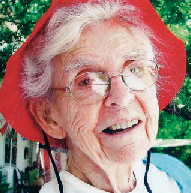
In Memoriam:
JANE ROBINSON HARTGE
Sailor, Author, World Traveler, Homemaker
Chesapeake Bay sailor Jane Robinson Hartge died on January 13, 2015, in Eustis, Florida.
Born in 1919 in Cincinnati, Jane spent a long lifetime happily centered on family and boating. At age 13, she began writing maritime articles for the
Miami Herald, reporting on the comings and goings of yachts large and small. Three years later she sailed with her father on his yacht to Venezuela and back through the Caribbean, keeping a journal that would later inspire her book,
The Way They Were: With Cachalot
to the Caribbees. At 19, she skippered the family's 40-foot schooner
Windstark from Florida to Maryland. The crew of four included her 17-year-old sister Mardi.
In 1941 she married Chesapeake Bay boatbuilder and designer Ernest "Captain Dick" Hartge, and started their family in Galesville. While her husband was designing and building boats, Jane began her own business, renting out a small fleet of sailboats. Following their move south in 1961, Jane and Captain Dick created a similar fleet on Lake Eustis, Fla., sparking a great sailing tradition that continues today as the Lake Eustis Sailing Club.
In her later years, she enjoyed writing of her life experiences. She was known until the end of her years for her astounding memory, with the tiniest details, especially of boats and boatyards, available instantly and completely.
Over her life she traveled, mostly by sea, to Europe, Canada, South and Central America, and her beloved Man O' War Cay, Abaco, Bahamas. Captain Dick passed away in 1979.
Burial will be later this year in St. Mary's City, Md.
CBM
gratefully acknowledges the Lake Eustis Sailing Club for this information.
February 10, 2015
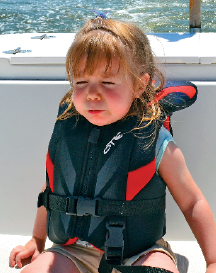
Building a Better Mousetrap Life Jacket
Do you remember the last time you wore a life jacket while boating? Yeah, me neither. That's the problem with most life jackets (also known as personal flotation devices, or PFDs): their bulky, uncomfortable attributes often prevent people from actually wearing them. And for a device that's supposed to save your life, that's a huge design flaw.
The BoatU.S. Foundation is hoping to take a step forward in solving this problem. Last fall the organization announced its 2015 Innovations in Life Jacket Design Competition, which promises $10,000 to the best new life jacket design or concept. Anyone can enter and the organization is encouraging entrants to "think outside the box," meaning the more unconventional the better. The hope is that a life jacket design may emerge that revolutionizes PFD usage among boaters and, in turn, saves lives.
A panel of boating industry experts will judge the entries based on a number of factors. Those interested can find complete details and an entry form at boatus.org/design. The deadline for entries is April 15. Winners will be announced in September at the International Boat Builders Exhibition and Conference in Louisville, Kentucky.
February 10, 2015
ActiveCaptain
A good cruising guide is a wonderful thing. It can entertain, direct and enlighten. While a printed guide can't be beat for easy, quick, reliable access to information in busy conditions, providing the Big Picture of an area in any kind of on-going up-to-date format is trickier. That's where web-based data shines.
ActiveCaptain (
activecaptain.com) is the 500-pound gorilla of online cruising references. Its reach and depth are astonishing. I looked at places around the world where I have sailed and found all of them covered thoroughly: The entire East coast of the U.S., Alaska's Inside Passage, all the Caribbean islands, the Atlantic and Mediterranean coasts of France and even southern Turkey. It's a worldwide cruising community newspaper. And it's free.
ActiveCaptain is crowd sourced. Skippers chip in with their comments on anchorages, marinas, obstructions and anything else that they consider pertinent. This is its strength and its weakness. Like anything else online, the data are only as good as the sources, so any prudent mariner will cross-check several references to a spot before accepting a comment as fact.
The Interactive Cruising Guidebook section shows charts, on which users set markers. As the site says, "You can edit the data in any marker as well as create and delete markers. This is your guidebook that is a shared resource with every other cruiser. All updates and additions are verified and validated and don't become part of the full database until we review them. What we're trying to do is capture the normal dock conversations that happen about good facilities, problem anchorages and other cruising information. When you add it to ActiveCaptain, you're making it available to the whole community."
Updates are continuous and older comments remain. This lets you look back to see if conditions have changed, such as ownership of a marina, date of channel dredging, closing of restaurants, new sandbars and so on.
Like a standard nav program, you can create and edit routes. You can also share your routes or copy any of the thousands already online. You can edit those for your own use, but you can't change them on the site, which preserves the integrity of the data.
A new function is the ActiveCaptain Companion, an iPad app. With it, you can download charts and cruising data at home, then use it when you are away from a WiFi connection. This is invaluable for real-world cruising.
Many nav system companies have integrated ActiveCaptain into their products and there is software for Mac, Windows, IOS and Android that include the data from the site.
ActiveCaptain is huge, useful and entertaining. Spend a few hours exploring it.
activecaptain.com
February 10, 2015
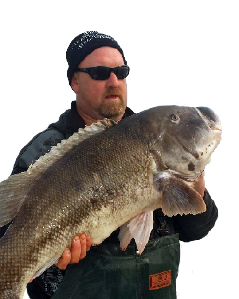 Photo courtesy Captain Kane Bounds
Photo courtesy Captain Kane Bounds
Angler Catches "Togzilla" off Ocean City, Md.
New York fisherman Kenneth Westerfeld lands a 28.8-pound tautog that could set new all-tackle International Game Fish Association record.
February 10, 2015
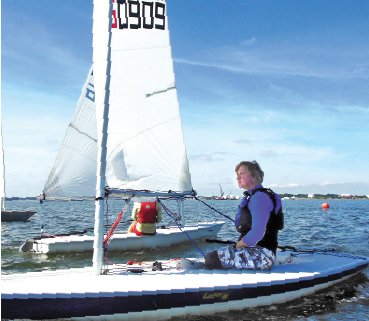 Photo courtesy of Lisa Suhay
Photo courtesy of Lisa Suhay
Hampton Roads Laser Sailor Nails Guinness World Record
Robert Suhay sailed 283.5 miles around the Bay in a 13-foot, nine-inch long sailboat to receive recognition for "the longest single-handed distance sailed in a dinghy by a male."
February 10, 2015
Last Call for Safety at Sea
Event highlighting offshore safety takes place at U.S. Naval Academy March 28-29. Visit
mtam.org/industry-events/safety-at-sea for details.
February 10, 2015
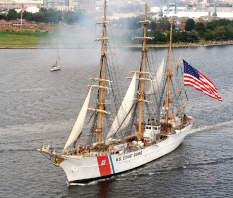 Photo courtesy of U.S. Coast Guard
Photo courtesy of U.S. Coast Guard
Tall Ship Eagle Gets the Spa Treatment at Coast Guard Station Curtis Bay
There's no doubt that $28 million is a lot of money, but when you're talking about a four-year complete refit of the U.S. Coast Guard's 295-foot tall ship USCGC
Eagle, maybe it seems like a relative bargain. And that refit is taking place right here on the Chesapeake Bay, at the U.S. Coast Guard's Curtis Bay Yard in Baltimore.
The three-masted barque, originally built in Hamburg, Germany, and surrendered to the United States in 1946 as part of reparations for World War II, slid into dry dock at the U.S. Coast Guard Yard at Curtis Bay this past September, after taking part in the Star-Spangled Banner Spectacular festivities in Baltimore Harbor. Once she settled down into a custom cradle, the steel-hulled giant was rolled ashore by diesel tow tugs and locked in place so that the $7 million first phase of the refurbishment could begin.
The most laborious and time-consuming aspect of the first phase is removing all 200 tons of the sailing ship's lead ballast, coating it to protect crew members from lead poisoning, and then returning each lead ingot to where it came from within the ship. In addition to the ballast work, crews also will strip down and recoat the USCGC
Eagle's three 137- to 147-foot tall masts, rework her steering gear, and assess the condition of her hull. Additional projects to add another 30 to 40 years to the ship's life will continue over the next four years at the yard as she sails in the summers and is taken out of service during the winter months.
The USCGC
Eagle is no stranger to the U.S. Coast Guard Yard in Curtis Bay. She was in the yard for repairs there as recently as 2011, and was in dry dock more than 30 years ago for the last major refit to extend her useful service life.
January 18, 2015
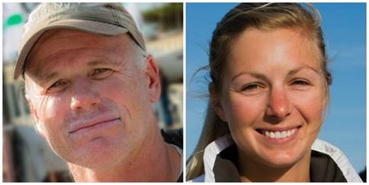
Annapolis sailor Terry Hutchinson is US Sailing's Yachtsman of the Year
Terry Hutchinson of Annapolis, Md., and Stephanie Roble of East Troy, Wis., have been named US Sailing's 2014 Rolex Yachtsman and Yachtswoman of the Year. A total of ten men and seven women had been shortlisted for the 2014 honors based on nominations submitted by members of US Sailing, with these two sailors then selected for the distinction by a panel of sailing journalists.
In 2014, Hutchinson reached the top of the leaderboard at major regattas more times than any other American sailor. The 2014 award is Hutchinson's second; he previously earned the honor in 2008 following his win of the TP52 World Championship.
As tactician on Alex Roeper's Plenty, Hutchinson won the Rolex Farr 40 World Championship. He also won the Rolex Farr 40 North American Championship and the California Cup and took class honors at the Rolex Big Boat Series. He also reclaimed the World Championship title in the TP52 class, collecting a class win at Quantum Key West Race Week as well as the TP52 U.S. Championship title. His success in one-design classes did not stop there. In the RC44, he won the Oman Cup as tactician; in the J/70 class, he drove to the win of the Fall Brawl in his hometown; and he finished second at the Melges 32 Gold Cup, again as tactician.
In winning the Yachtwoman of the Year award, Roble was cited as a member of the Etchells World Championship winning team. She also crewed on the seventh-place finisher at the J/70 North American Championship, and the fifth-place finisher at the Melges 20 North American Championship. As a skipper, she won the U.S. Women's Match Racing Championship and placed third at the ISAF Women's Match Racing World Championship. Based on her 2014 match racing results, she begins the New Year as the top American match racer, with a ranking of number three in the world.
January 16, 2015
Angler Lands Record Chain Pickerel
Long-time chain pickerel fisherman, Lee Haile III, of Towson, Md., was fishing on a pond near Salisbury, Md., when he landed "the big one," an eight pounder-a new Maryland record. Haile was using light spinning tackle with eight-pounded braided running line, a 20-pound monofilament leader, and a minnow/jig combo lure. The previous state record-holder was a seven-pound, four-ouncer caught in 1976 and the world record is nine pounds, four ounces (caught in Georgia in 1961).
If you think you've got a winning catch, contact DNR at 443-569-1381 or 410-260-8325. The agency recommends anglers "keep their fish immersed in ice water to preserve its weight until it can be checked, which can be done at a seafood retailer, a grocery store, or tackle shop with a certified scale." The Maryland State Record application and a list of records can be found at
http://dnr2.maryland.gov/fisheries/Pages/default.aspx
January 16, 2015
A Prize Bite
Much to her delight and amazement, when Virginia Beach resident Karen Morelli bit into a littleneck clam purchased at the Great Machipango Clam Shack in Nassawadox, Va., she realized there was a prize inside-a lovely, lavender 4.5-carat pearl worth about $3,000. The grower, Billy Bowen of B&E Seafood in Willis Wharf, Va., says he has never seen a pearl in an aquaculture clam in his 25-year career, though they are not that uncommon (at least small ones) in natural clams. He estimates the age of the clam to be one-and-a-half to two years old. Like the shell of a clam, a pearl is composed of calcium carbonate that has been deposited over a period of time in concentric circles. Natural, non-cultured, gem-quality pearls are quite rare, regardless of what species of mollusk produces them.
January 16, 2015
Marine Trades Summer Internship Training Program
The Marine Trades Association of Maryland is offering a pre-apprentice program for the summer of 2015. The program includes a maritime immersion workshop taught over the weekend of May 1-3 at Camp Letts in Edgewater, Md. Following the completion of the weekend course, applicants will be eligible for placement into a six-week paid summer internship that will start at various times after Memorial Day, depending on the discretion of the hiring organization. Information and application at
http://www.mtam.org/jobs-career-training/training-for-the-marine-trades/application.
January 16, 2015
Discount on Maryland Fishing License
If you haven't bought a tidal or nontidal fishing license in Maryland since 2011 now's the time to dust off the tackle and buy a license for the 2015 season with a special 50% discount from MD DNR. The promotion is designed to promote all the great fishing to be found in Maryland waters. You'll have to move quickly though-the offer expires January 31.
http://news.maryland.gov/dnr/2014/12/19/7807/
January 11, 2015
Here is some very timely advice from CBM contributor Tom Hale:
Cold weather leads to shore power cord damage and boat fires
During the cold weather this week there have been several boat and marina fires including one in Kinsale, VA. The cause has been attributed to the heater in the boat. The heater is probably not the real culprit. The culprit is the heater and all the other devices in the boat drawing a lot of current through a corroded shore power cord inlet. I urge each of you who live aboard, to go outside and check your cord. The end of the cord should be no warmer than the ambient temperature. Put a hand on it. If it is warm, you have a problem. If the dock end overheats and catches fire, you MAY have a marina fire. If the boat end overheats and catches fire your boat WILL burn! Please check it right now. Check it again this evening when the day cools off and the heaters kick on. Check it again in the morning when the heaters have been running all night. The cord end should not be getting hot! While you are out checking, check on your neighbors' cords too. The boat you save may be your own.
The pictures attached show a hull inlet that is melted and burned. The other shows a dock receptacle that has started to show discoloration. This receptacle has already experienced some overheating.
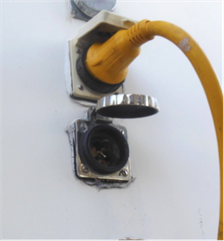
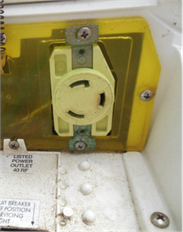
January 10, 2015
Boats lost in Port Kinsale (Va.) Marina fire
A fire early Friday morning destroyed a number of boats under a cover-dock at Port Kinsale Marine on the Northern Neck of Virginia. Here are some of the details from Terry Moss. The photo was taken by Jeffrey Moss.
Four boats and the covered boat shed were destroyed. Only one of the boats, the sturdy old wooden SUBEK remained above the waterline after the fire, according to Moss. Investigators began work Saturday morning.
Two Moss family boats were destroyed, SUBEK and
Pamela Sue.
The SUBEK was built in Deltaville, Va., in 1961 for Jimmy and Scottie Moss's Uncle Ben Moss. Ben's brother, Joe Bill Moss, and then Scottie Moss carried fishing parties on SUBEK for many years. She was signed over to Jimmy after her commercial use was discontinued. Since then, family and friends have enjoyed fishing parties aboard her.
SUBEK was named for Ben's daughter Susan and his collie, Becky. "The boat is a big part of the Moss family's heart So many good memories," Terry said. Scottie's current fishing boat, the fiberglass
Pamela Sue, also was lost in the fire.
According to Terry, two of the other boats that were burned were a vintage Chris Craft called the Pentimento, owned by the late Peter and Julia Williams, and
Revelation, owned by Bob and Hollie Lovelace.
Terry said the fire was contained to the covered boat shed with no damage to the campground, the Mooring restaurant, the Skipjack Inn or therental units for rent thanks to the efforts of a pump-boat from Cobb
Island, the fire boat from Kinsale, Kinsale firefighters and firefighters from Callao and Montross.
January 7, 2015
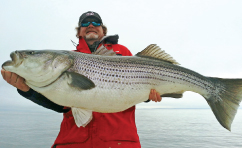 Photo courtesy of Shawn Kimbro
Photo courtesy of Shawn Kimbro
Rockfish Roundup
Spawning Numbers Remain Below Average, Atlantic States Marine Fisheries Commission Cuts Harvest
Commonly known around much of the Chesapeake Bay as "rockfish," the striped bass (
Morone saxatilis) has had good years and bad all along the Atlantic coast since a moratorium on the harvest of the species ended in 1990. Ask pretty much any angler about the state of the fishery during the last five or six years, however, and the response you'll likely get is, "Meh." Two bits of recent rockfish news generally support Chesapeake anglers' apathetic views of the fishery.
On October 20, 2014, the Maryland Department of Natural Resources (DNR) released its Juvenile Striped Bass Index, which measures the spawning success of the fish in Chesapeake Bay by collecting and counting juvenile striped bass from beach seine nets each year. Although the DNR described the index results as "healthy," the numbers actually show below-average reproduction. The 61-year average for the DNR index is 11.7, while the 2014 index clocked in at 11.0. The Virginia Institute of Marine Science's similar Juvenile Striped Bass Seine Survey returned slightly better results, showing 11 fish per seine haul versus the historic average of nine. While scientists generally agree that striped bass reproduction is highly cyclical, there have been more below- than above-average years over the last decade.
News that might help reverse that trend came on October 29, 2014, when the Atlantic State Marine Fisheries Council (ASMFC) met in Connecticut. The ASMFC is made up of commissioners from every Atlantic Ocean state and is tasked with managing 25 near-shore fish species, including striped bass. ASFMC commissioners voted to cut the Chesapeake Bay striped bass harvest by 20.5 percent in 2015. The goal is to return the striper population to target levels within two years.
The decision was based on the last scientific stock assessment, which was completed in 2013. It confirmed that overfishing of the species had been occurring at least six of the previous nine years. What this likely means for recreational anglers in Maryland and Virginia is a bump in the minimum harvest size of 18 inches to 20 inches with a two fish per angler/per day limit during the regular summer season. Maryland and Virginia have differing geographic, harvest and minimum size regulations in the spring and fall seasons, but expect to see changes to those regulations, too. Most notably, the minimum 28-inch size for stripers during the Maryland spring trophy season will likely go up to 36 inches.
The harvest restrictions will affect only the 2015 fishing season for both the commercial harvest and recreational anglers. Both Maryland and Virginia were supposed to submit plans for new regulations for approval by late November. Finalized size and harvest regulations were expected to be out in December.
January 7, 2015
Bay Restoration Worth Billions to Chesapeake Economy
It turns out that restoring the Chesapeake Bay is worth more than $22.5 billion to states in the Bay Watershed annually, according to a recently released, peer-reviewed Chesapeake Bay Foundation (CBF) report. And the benefits to your own wallet just might surprise you.
So what, exactly, is that $22.5 billion number all about? The numbers in the report assume the successful and complete implementation of the Chesapeake Clean Water Blueprint. The Blueprint is an effort by the District of Columbia and the six states (Delaware, Maryland, New York, Pennsylvania, Virginia and West Virginia) that lie within the Chesapeake Bay Watershed to reduce the amounts of nitrogen, phosphorous and sediments that flow into the Bay. The Blueprint's goal, CBF says, is to "Ensure pollution reduction and result in the 'fishable, swimmable' waters promised by the Clean Water Act of 1972." All six states and the District of Columbia signed the Blueprint agreement last year.
In 2009, before the Blueprint was put in place, the lands and waters of the Chesapeake Bay Watershed provided natural economic benefits worth $107.2 billion annually. Successfully implement the Blueprint and that number goes up by $22.5 billion, the report says. It's that simple. Maryland, Virginia and Pennsylvania would benefit the most-by $4.6, $6.2 and $8.3 billion per year, respectively.
Other benefits would include improved water filtration, increased agricultural and seafood production, and enhanced property values. Pre- serving and augmenting wetlands and woodlands would help filter out airborne pollution and contain floodwaters and storm runoff. For boaters, the benefits include safe and pleasant waters. Anglers and crabbers would enjoy better fishing.
The report states that if we simply maintain a "business as usual" stance, maintaining the current, pre-Blueprint level of Bay restoration, the economic value of the Bay watershed will decline by some $5.6 billion.
While the report addresses the benefits, not the cost of implementing the Blueprint, CBF reports that an earlier estimate pegs Blueprint implementation at roughly $6 billion per year. Given that the do-nothing approach costs the region almost the same amount, doing the right thing seems like a no-brainer.
For more information visit
cbf.org.
January 7, 2015
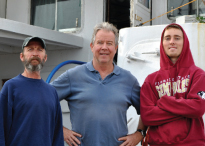
A Note from Jody
As
Moment of Zen was pulling out of Golden Isles Marina on St. Simons Island, Georgia, this winter, I spotted a well-worn steel workboat with a Tarpon Springs, Florida, homeport. A long way from home for a sponge boat, I thought.
Aqua Quest, I soon discovered, was far more interesting than a sponge boat. "We're diving a wreck here," crew member Kelly "BooBoo" Garrett told me. Turns out they are treasure hunters! And rather well-known ones at that. "Aqua Quest International has dived wrecks from coastal Maryland to Bimini," Garrett said. The wreck they were diving off St. Simons was called the Elizabeth City.
"Maybe you read about us or saw us on television," Garrett continued. "We were put in jail in Honduras for diving illegally, even though we were asked by the government to come."
Aqua Quest president Bob Mayne took over at this point and explained that they had been in Honduras to dive river oxbows, looking for the lost cargo of old ships bound for England. "The ship timbers are long gone," Mayne said, "but their cargo of mahogany, which was harvested to rebuild London after the fire, is still there and more valuable than ever." The wood becomes even harder and more beautiful for its time in the water, he said. "Each log is worth about $30,000." (They'll be heading to Honduras again.) If you'd like to read more about Aqua Quest, go to
aquaquestinternational.com.
-
Jody Argo Schroath, Moment of Zen
January 7, 2015
 Photo courtesy of U.S. Coast Guard
Photo courtesy of U.S. Coast Guard
Tall Ship Eagle Gets the Spa Treatment at Coast Guard Station Curtis Bay
There's no doubt that $28 million is a lot of money, but when you're talking about a four-year complete refit of the U.S. Coast Guard's 295-foot tall ship USCGC
Eagle, maybe it seems like a relative bargain. And that refit is taking place right here on the Chesapeake Bay, at the U.S. Coast Guard's Curtis Bay Yard in Baltimore.
The three-masted barque, originally built in Hamburg, Germany, and surrendered to the United States in 1946 as part of reparations for World War II, slid into dry dock at the U.S. Coast Guard Yard at Curtis Bay this past September, after taking part in the Star-Spangled Banner Spectacular festivities in Baltimore Harbor. Once she settled down into a custom cradle, the steel-hulled giant was rolled ashore by diesel tow tugs and locked in place so that the $7 million first phase of the refurbishment could begin.
The most laborious and time-consuming aspect of the first phase is removing all 200 tons of the sailing ship's lead ballast, coating it to protect crew members from lead poisoning, and then returning each lead ingot to where it came from within the ship. In addition to the ballast work, crews also will strip down and recoat the USCGC
Eagle's three 137- to 147-foot tall masts, rework her steering gear, and assess the condition of her hull. Additional projects to add another 30 to 40 years to the ship's life will continue over the next four years at the yard as she sails in the summers and is taken out of service during the winter months.
The USCGC
Eagle is no stranger to the U.S. Coast Guard Yard in Curtis Bay. She was in the yard for repairs there as recently as 2011, and was in dry dock more than 30 years ago for the last major refit to extend her useful service life.
January 7, 2015
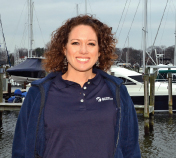 Photo by Mark Talbott
Photo by Mark Talbott
Progressive Insurance Baltimore Boat Show Rolls into Charm City
If you're like most Bay boating enthusiasts, winter likely has you looking for an excuse to get out of the house. Lucky for you, the Progressive Insurance Baltimore Boat Show is on the way, filling the Baltimore Convention Center with boats, fishing tackle and all things nautical from January 29 to February 1.
Now in its 61st year, the 2015 show promises to be bigger than ever, thanks to the efforts of show manager Tara Davis, who has managed to build the event into one of the fastest growing marine shows in the country. Her innovative touches include establishing on-site opportunities to "get your learn on," with seminars and workshops covering everything from fishing tips and tactics to sessions on seamanship and diesel mechanics.
Meanwhile on the showroom floor you'll find displays from major boat, gear and marine electronics manufacturers, as well as representatives from marine services companies like insurance and finance providers. It's also a great place to shop for a place to keep your boat, plan your next charter vacation, or get your boating questions answered by the pros.
Admission to the show is $12 for adults; children 15 and younger are admitted free with a paid adult admission. Show hours are 11 a.m. to 9 p.m. January 29 and 30, and 10 a.m. to 9 p.m. January 31 and February 1.
Pre-purchase tickets at
baltimoreboatshow.com with code CBM and receive a 33% discount!
January 7, 2015
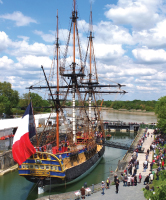 Photo courtesy of L'Herminone Project
Photo courtesy of L'Herminone Project
Frigate L'Hermione to Visit Five Chesapeake Bay Ports This Summer
Five Chesapeake Bay ports will play host this summer to the newly commissioned French tall ship frigate
L'Hermione, an accurate replica of the same vessel that carried Frenchman Marquis de Lafayette to America in 1780. In total, the 213-foot ship will visit 12 North American ports as part of a voyage that takes her from the coast of France across the Atlantic Ocean, up the Eastern Seaboard from Yorktown, Va., to Halifax, Nova Scotia, and then back to Brest and Ile d'Aix in France.
Construction of the replica ship took 16 years and was completed using drawings taken from
L'Hermione's sister ship, La Concorde. More than three million people have donated funds to support the ship's construction and voyage across the Atlantic.
The voyage is a celebration not only of the ship, but also of Marie-Joseph Paul Yves Roch Gilbert du Motier, known more familiarly as Marquis de Lafayette, the French major general who volunteered his services to the Continental Army during the American Revolutionary War. Both
L'Hermione and Lafayette played many roles in the war, particularly in and around the Chesapeake Bay region.
Of particular note, Lafayette and
L'Hermione participated in the Siege of Yorktown, in which Lafayette organized guerilla attacks against British supply units. The subsequent naval blockade squeezed Cornwallis and his troops to the point of surrender after the defeat of the British Navy in the Battle of the Chesapeake, which took place near the mouth of the Chesapeake Bay in September of 1781 (the struggle is also known as the Battle of the Virginia Capes).
L'Hermione will embark from the mouth of the River Charent in Port-des-Barques, France, on April 25, 2015, arriving in Yorktown around June 5. The ship will then visit four additional Chesapeake ports before heading to Philadelphia and New England.
For more information visit
hermione2015.com.
L'Hermione's Chesapeake Ports of Call: June 5 to June 7: Yorktown, June 9: Mount Vernon, June 10 to June 11: Alexandria, June 15 to June 17: Annapolis, June 19 to June 21: Baltimore
January 7, 2015
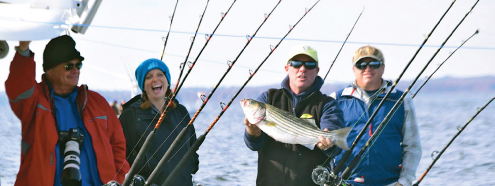
Goooo Team CBM!
November is tournament rockfish season here on the Bay and this year
Chesapeake Bay Magazine got in on the action! The magazine sponsored a team of anglers from Annapolis to fish in the annual Fish For a Cure Tournament (
www.fishforacure.org), which raises money for the DeCesaris Cancer Institute at Anne Arundel Medical Center in Annapolis (and raises quite a lot of it . . . over $250,000 in 2014!).
Our crack team consisted of Captain Tom Weaver, Captain (and boatowner) Dave Wood, Ian Gordon, Scott Snyder and Matt Beck. Fishing from the Eastport 32
Sea Toy Jr., Team
Chesapeake Bay Magazine reeled in the tournament's 7th place rockfish, which weighed in at 7 pounds, 8 ounces. The anglers, who have fished together for six years in tournaments around the Chesapeake and beyond, also raised an impressive $3,050 to support the DeCesaris Cancer Institute. The group was proud to donate the funds in the memory of Captain Steve Dodson, a friend and fellow angler who passed away this summer after a battle with brain cancer.
Team
CBM wasn't the only member of the magazine family out fishing for a cure that day-our favorite fishing guru John Page Williams also participated, snagging the tournament's top ranked perch!
January 2, 2015
Kent Narrows Bridge security zone
Mariners are advised that to facilitate planned bridge repairs to the Kent Island (MD-18B) Draw Bridge, a Coast Guard safety zone will be established in Kent Island Narrows from December 15, 2014, through on February 16, 2015. The work involves the removal and replacement of the bascule span bracing members and retrofit the bascule span stringers located over the federal navigation channel.
The safety zone includes all waters of Kent Island Narrows within an area bounded by position latitude 38°58'14.5"N, longitude 076°14'50.2"W; thence easterly to position latitude 38°58'14.1"N, longitude 076°14'48.4"W; thence southerly to position latitude 38°58'12.3"N, longitude 076°14'49.0"W; thence westerly to position latitude 38°58'12.8"N, longitude 076°14'50.8"W; thence northerly to the position of origin, located in Queen Anne's County, MD (reference Datum NAD 1983). This area, which applies to the entire width of the federal navigation channel, allows for the placement of marine equipment that will remain in the federal navigation channel 24 hours per day for the 63-day period. This safety zone will be enforced from 6 a.m. on December 15, 2014 through 6 a.m. on February 16, 2015.
With the exception of Maryland State Highways Administration support vessels, entry into or remaining in this zone is prohibited unless authorized by the Coast Guard Captain of the Port (COTP) Baltimore. Persons desiring to transit the area of the safety zone must first obtain authorization from the COTP Baltimore or his designated representative, which can be contacted at telephone number 410-576-2693 or on Marine Band Radio VHF-FM channel 16. Vessels and persons transiting Kent Island Narrows outside the safety zone do so at their discretion. It is crucial mariners operating near the work site eliminate wakes.
During the period of the bridge repair project, USCG bridge opening regulations for the draw bridge will remain unaffected. Interested mariners can contact the Kent Narrows Bridge Tender via marine band radio VHF-FM channel 13 or at telephone (410) 643-5963. Coast Guard Sector Baltimore Waterways Management Division can be contacted at telephone (410) 576-2674 or (410) 576-2693. Charts 12272, 12270.
Coast Guard proposing to add AIS Synthetic Aids to Navigation in the Chesapeake
The U.S. Coast Guard is proposing to add AIS Synthetic ATON marks to the following aids:
CHESAPEAKE BAY (VIRGINIA) - CHESAPEAKE BAY ENTRANCE - CHESAPEAKE CHANNEL Chesapeake Channel Lighted Buoy 13 (LLNR 7105) at position 37-02-26.000N / 076-04-17.000W
CHESAPEAKE BAY (VIRGINIA) - CHESAPEAKE BAY ENTRANCE - CHESAPEAKE CHANNEL Chesapeake Channel Lighted Buoy 14 (LLNR 7110) at position 37-02-31.001N / 076-04-02.876W
SEACOAST (VIRGINIA) - OCEAN CITY INLET TO CAPE HATTERAS Chesapeake Bay Entrance Lighted Whistle Buoy CH (LLNR 405) at position 36-56-08.329N / 075-57-26.543W
SEACOAST (VIRGINIA) - OCEAN CITY INLET TO CAPE HATTERAS - CHESAPEAKE BAY SOUTHERN APPROACH Chesapeake Bay Southern Approach Lighted Whistle Buoy CB (LLNR 410) at position 36-48-59.743N / 075-45-36.013W
CHESAPEAKE BAY (VIRGINIA) - CHESAPEAKE BAY ENTRANCE - CHESAPEAKE CHANNEL Chesapeake Channel Lighted Buoy 40 (LLNR 7240) at position 37-21-49.490N / 076-04-27.768W
CHESAPEAKE BAY (MARYLAND) - COVE POINT TO SANDY POINT - CHESAPEAKE CHANNEL Chesapeake Channel Lighted Buoy 78A (LLNR 7682) at position 38-34-42.000N / 076-25-53.000W
CHESAPEAKE BAY (MARYLAND) - SANDY POINT TO SUSQUEHANNA RIVER - UPPER CHESAPEAKE CHANNEL Upper Chesapeake Channel Lighted Buoy 45 (LLNR 8870) at position 39-22-10.839N / 076-07-45.462W
CHESAPEAKE BAY (MARYLAND) - SANDY POINT TO SUSQUEHANNA RIVER - UPPER CHESAPEAKE CHANNEL Upper Chesapeake Channel Lighted Buoy 46 (LLNR 8875) at position 39-22-05.831N / 076-07-41.366W
CHESAPEAKE BAY (MARYLAND) - SANDY POINT TO SUSQUEHANNA RIVER - UPPER CHESAPEAKE CHANNEL Upper Chesapeake Channel Lighted Buoy 47 (LLNR 8895) at position 39-22-50.744N / 076-06-10.205W
CHESAPEAKE BAY (MARYLAND) - SANDY POINT TO SUSQUEHANNA RIVER - UPPER CHESAPEAKE CHANNEL Upper Chesapeake Channel Lighted Buoy 48 (LLNR 8900) at position 39-22-45.337N / 076-06-07.068W
CHESAPEAKE BAY (MARYLAND) - SANDY POINT TO SUSQUEHANNA RIVER - ELK RIVER CHANNEL Elk River Channel Lighted Buoy 1ER (LLNR 8925) at position 39-23-51.238N / 076-03-16.828W
What is an AIS ATON?
AIS is an internationally adopted radio communication protocol that enables the autonomous and continuous exchange of navigation safety related messages amongst vessels, lifeboats, aircraft, shore stations, and aids to navigation (AIS ATON). AIS ATON stations broadcast their presence, identity (9-digit Marine Mobile Service Identity (MMSI) number), position, and status at least every three minutes or as needed.
Synthetic AIS ATON's signal can be received by any existing AIS mobile device, but they would require an external system for their portrayal (i.e., AIS message 21 capable ECDIS, ECS, radar, PC). How they are portrayed currently varies by manufacturer, but the future intention is for the portrayal to be in accordance with forthcoming International Standards (i.e., IEC 62288 (Ed. 2), IHO S-4 (Ed. 4.4.0)).
Comments on this proposal in writing, either personally or through their organization, may be sent to: Commander (dpw)
Fifth Coast Guard District 431 Crawford Street, Rm.100 Portsmouth, VA. 23704
Or email to: [email protected]